





Academic Authors: Sneha Sharma, Anuj Gupta, Sayani Sarkar, Chandni Bhargava
Creative Director: Bhavna Tripathi
Book Production: Vishesh Agarwal, Amisha Gupta
VP, Learning: Abhishek Bhatnagar
All products and brand names used in this book are trademarks, registered trademarks or trade names of their respective owners.
© Uolo EdTech Private Limited
First impression 2025
This book is sold subject to the condition that it shall not by way of trade or otherwise, be lent, resold, hired out, or otherwise circulated without the publisher’s prior written consent in any form of binding or cover other than that in which it is published and without a similar condition including this condition being imposed on the subsequent purchaser and without limiting the rights under copyright reserved above, no part of this publication may be reproduced, stored in or introduced into a retrieval system, or transmitted in any form or by any means, electronic, mechanical, photocopying, recording or otherwise, without the prior written permission of both the copyright owner and the above-mentioned publisher of this book.
Book Title: Dawn Teacher Manual Level B Part-III
ISBN: 978-81-985727-3-8
Published by Uolo EdTech Private Limited
Corporate Office Address:
85, Sector 44, Gurugram, Haryana 122003
CIN: U74999DL2017PTC322986
Illustrations and images: www.shutterstock.com, www.stock.adobe.com and www.freepik.com
All suggested use of the internet should be under adult supervision.

he early years of education serve as the cornerstone for a child’s cognitive, social, and emotional development. This crucial stage is not solely about literacy and numeracy but about enabling holistic growth, ensuring that children develop into confident, inquisitive, and well-rounded individuals. The DAWN curriculum has been meticulously designed to be in alignment with the National Education Policy (NEP) 2020 and the National Curriculum Framework for Foundational Stage (NCF-FS) 2022, thereby integrating the Panchakosha framework—a five-dimensional approach that nurtures physical, emotional, intellectual, social, and moral development in young learners—within the scope of this curriculum.
The curriculum follows a structured 180-day teaching plan, ensuring a well-paced and progressive learning journey. The 4+1 Teaching Model offers a balanced approach, with four days dedicated to new learning and the fifth day—the Catch-up Carnival—focused on revision and personalised support. This model ensures that every child consolidates learning effectively while receiving additional reinforcement where needed.
A Curriculum Rooted in the Panchakosha Framework
The DAWN curriculum is not merely a sequence of lessons; it is an experiential and thoughtfully designed learning journey that strengthens all five dimensions of the Panchakosha framework:
1. Physical Development – Through movement-based activities, action rhymes, gross and fine motor skill exercises, yoga, and simple meditation practices, children enhance coordination, balance, and self-regulation.
2. Social and Emotional Growth – Circle Time discussions, role-play, games, storytelling, and collaborative activities encourage empathy, cooperation, self-expression, and social awareness.
3. Intellectual Growth – The structured and age-appropriate progression of literacy and numeracy concepts, moving from concrete to abstract understanding, strengthens problem-solving skills, logical thinking, and foundational cognitive abilities.
4. Spiritual and Moral Development – Stories, rhymes, discussions, and guided reflections help children understand fundamental values such as kindness, honesty, patience, and respect for both people and the environment. Guided yoga and meditation help children stay calm, focus better, and feel happy.
5. Sensory and Experiential Learning – The DIY section provides opportunities for art and craft, STEM-based explorations, rhymes, stories, and interactive games, ensuring hands-on engagement, creativity, and imaginative thinking.
The curriculum has been carefully structured for ease of implementation, ensuring that lessons are engaging, developmentally appropriate, and seamlessly executable with minimal resources. Pro tips, error alerts, and best-practice strategies equip teachers with the tools needed to deliver lessons effectively while maintaining a structured and stimulating learning environment.
This manual is not just a teaching guide but a comprehensive support system designed to make classroom instruction efficient, engaging, and impactful. Each lesson follows a well-defined sequence, ensuring a smooth flow of activities that build upon prior knowledge, making learning meaningful and enjoyable.
By following this manual, teachers can confidently create a nurturing, inclusive, and stimulating learning environment, ensuring that every child progresses at their own pace while developing a strong foundation for future learning and personal growth. Through this collaborative journey, let us empower young learners to explore, discover, and thrive—one meaningful lesson at a time.



• Structured 180-Day Plan – The curriculum is designed with 150 teaching days dedicated to introducing and developing new concepts, and 30 revision days to reinforce learning and strengthen the understanding of one concept before moving forward to the next.
• 4+1 Teaching Model – A systematic and balanced approach where the first four days in a week focus on new learning, ensuring concept clarity and skill-building, while the fifth day is dedicated to revision and reinforcement. This structured progression helps children absorb, apply, and retain knowledge effectively.
• Catch-up Carnival: A Dedicated Revision and Support Day – The 5th day of every week is designed to consolidate learning and provide targeted support through:
Revisiting and Strengthening Weekly Learning – A structured review session that ensures children have the opportunity to recap and reinforce concepts introduced during the week.
Providing Additional Support for Struggling Learners – Carefully designed guidance, scaffolding techniques, and engaging revision strategies to help children who need extra time and practice to grasp key ideas.
• Strong Emphasis on Core Subjects – The curriculum provides comprehensive coverage of General Awareness, Literacy, and Numeracy. Every lesson is carefully designed to enhance cognitive skills, logical reasoning, and problem-solving abilities, ensuring children develop a strong academic foundation.
• Dynamic Circle Time Engagement – Thoughtfully structured Circle Time activities to kickstart the day on a positive note, and promote physical agility, emotional intelligence, social skills, moral values and spiritual awareness. Teachers are provided with a variety of interactive discussions, songs and rhymes, stories and role play scenarios, guided meditation, yoga practices, and mindfulness exercises to help children kickstart their day on a positive note.
• Hands-on Learning through the DIY Section – A dedicated enrichment segment at the end of each day, the DIY section offers STEM explorations, Art & Craft activities, storytelling sessions, song and dance, fun activities and interactive games. These experiential activities not only encourage creativity, motor development and sensory learning, but also add a flavour of joy in day-to-day learning.
3. Engaging Learning Approach: A Structured and Interactive Experience
•

Seamless Daily Flow – Each day follows a well-structured sequence, ensuring a smooth transition between activities and concepts. This thoughtful flow allows children to grasp new ideas naturally while reinforcing prior learning in a logical and engaging manner.


• Step-by-Step Lesson Guidance – Clear, concise, and easy-to-follow lesson plans provide teachers with structured guidance, ensuring confident, organised, and effective lesson delivery.
• Multisensory Learning Approach – Lessons are designed to stimulate multiple senses, incorporating visual, auditory, and kinesthetic activities. This approach enhances retention, strengthens comprehension, and makes learning more dynamic and interactive.
• Progressive & Play-Based Activities – Carefully curated play-based learning experiences align with children's developmental needs, ensuring a smooth transition from concrete exploration to pictorial representation and symbolic understanding. This gradual progression builds confidence and deepens understanding.
• Pro Tips for Teachers – Expert-backed teaching strategies and classroom management tips help educators enhance student engagement, encourage participation, and maximise learning outcomes.
• Error Alerts for Caution – Carefully curated guidelines on common teaching pitfalls ensure that lessons are delivered smoothly and effectively, helping teachers avoid misconceptions and common errors or mistakes.
• Creative Homework Ideas – Engaging, hands-on, and age-appropriate homework activities encourage playful learning beyond the classroom, reinforcing key concepts in a fun and meaningful way.
1. Use Fun Attention Getters – Clap patterns, call-and-response chants, or simple signals like “1-2-3, eyes on me!” keep kids engaged.
2. Use a Soft Signal for Attention – Instead of raising your voice, use a bell, a clapping pattern, or a simple phrase like "Hands on your head!"
3. Print-rich Environment – Use pictures and words to label materials in the classroom for creating a print-rich environment.
4. Create Clear Rules – Keep the rules simple and display them with pictures so kids can easily remember.
5. Use Positive Reinforcement – Notice good behavior and give compliments or badges often to encourage more of it. Praise good behaviour by saying "I love how quietly you are sitting!" instead of pointing out who isn’t.
6. Use Visual Schedules – A daily routine chart helps kids know what to expect and feel secure.
7. Make Transitions Exciting – Use songs or movement games to smoothly switch between activities.
8. Use Colour Cues for Noise Levels – Display a red sign for silent work, yellow for low talking, and green for discussion time.
9. Keep Instructions Short & Sweet – Young learners need clear, simple directions. Too many words can confuse them.
10. Use Movement Breaks – Brain breaks, stretching, or dancing help keep little bodies and minds active.
11. Have a Magic Word – A special word (like “popcorn”) can signal kids to listen or freeze.
12. Keep Supplies Organized – Label bins and shelves with pictures so kids can easily find and put away materials.
13. Use a Talking Object – Pass around a soft toy or ball; only the person holding it can talk.
14. Use Ice-cream Sticks – Write each student's name on an ice-cream stick, randomly pick one, and invite that child to answer.
15. Set Up a Turn-taking Chart – Write names in order so kids know when their turn is coming.
16. Mix Up Seating Arrangements – Change partner or group work setups to keep children engaged and encourage teamwork.
17. Have a "Mystery Motivator" – Randomly surprise children with a small reward for good behaviour (e.g., extra playtime).
18. End the Day on a Happy Note – Have a short "What did you learn today?" or "One thing that made you smile!" discussion before leaving.




Circle Time
General Awareness
Plants and Their Uses
Foundational Literacy Do and Learn Literacy Skillbook, page 54
Foundational Numeracy Far and Near Numeracy Skillbook, page 54
DIY The Pichkari Art and Craft, pages 20–21
LO: Children will play a fun game to share their imagination.
Resources: A soft toy
1. Imagine Together: Begin with prompts like: If I were a bird, I would fly in the sky. Or If I were a fish, I would swim in the water. Use expressive gestures and voice.
2. If I Were: Pass around a soft toy. Ask each child holding the soft toy: If you were an animal or a thing, what would you be? Help them with examples if needed. Encourage imagination—they can say anything (e.g., balloon, sun, car). After each child shares, invite them to show a small action related to their choice (e.g., flapping arms for a bird, turning around for a spinning top).

LO: Children will identify parts of a plant and talk abou their uses.
Resources: A small potted plant; a fruit
1. Looking at a Plant: Bring a small potted plant or leaf into the circle. Say: Look at this! What do you see? This is a plant. Can you find the leaves? The stem?
Encourage the children to carefully feel and observe the different parts of the plant using their hands.
2. Importance of a Plant: Use real-life examples to discuss the importance of plants with children. Say:
• Plants give us fruits like mangoes and bananas. (Show a real fruit if possible.)
• We get flowers from plants. Who has seen a flower?
• Trees give us shade. Do you sit under a tree in the park?
Ask: Have you ever seen a plant at home or outside? Encourage children to share.
3. Plant Movement: Say: Let’s grow like a plant!
• Crouch down like a seed.
• Wiggle fingers like roots.
• Slowly stand and stretch arms like growing branches. Let children copy and learn through movement!







LO: Children will identify objects beginning with the letters Q, R, S and T.
Resources: Literacy Skillbook, page 54; sticker sheet (from Skillbook); Q–T letter flashcards (from Skillbook)
1. Letter Symbols: Write the uppercase letters of Q, R, S and T on the board one by one and ask children to hold up the flashcards that show the corresponding lowercase letters. Monitor and guide children as required
2. Identifying Letter Sounds: Say aloud words starting with /kw/, /r/, /s/ and /t/ sounds in a random order. Ask children to listen to the words carefully, and hold up the correct letter flashcard. Guide children, as required.
3. Do and Learn: Ask children to open page 54 of the Skillbook. First, guide them to identify the pictures and paste the correct letter beside each picture. Then, ask them to match the uppercase letters with their corresponding lowercase letters.






LO: Children will identify the positions “near” and “far” using real objects around them.
Resources: Numeracy Skillbook, page 54; some common classroom objects
1. Explaining Near and Far: Hold up two familiar classroom objects—one close to you (e.g., a pencil box) and one placed far across the room (e.g., a chair or bag). Say: Look! This pencil box is near me. Can I touch it? (Yes) / That chair is far from me. Can I touch it from here? (No) Repeat the words near and far clearly.
2. Observation Time: Call children one by one. Point to different objects around the classroom. Ask questions like: Is the blackboard near or far from you? / Is your friend sitting near or far? Let children answer and then ask children to point to one object that is near and one that is far from them.

3. Far and Near: Ask children to open page 54 of the Skillbook. First, help them identify objects that are far and near with the help of pictures. Then, read the sentences aloud along while pointing at the pictures.
Look at different objects around, at home. Try to identify the objects that are far and the ones that are near.






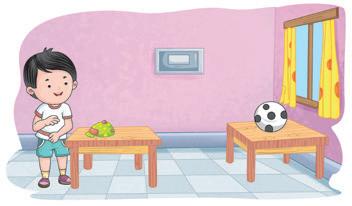





LO: Children will create colourful paintings using drops of colour. Resources: Art and Craft, pages 20–21; water colour; tube or paint brush; straws (1 per child)
1. Warm-Up: Ask: What do you do on the festival of Holi? Let children share their responses. Then talk about a pichkari and how water splashes out of a pichkari. Say: Today we will make an artwork where we will make splashes from a pichkari.








2. The Pichkari: Ask children to open pages 20–21 of the Art and Craft book. Guide them to make the artwork by following the step-by-step instructions given on page 20. Assist those who need help.
Circle Time
General Awareness
Name Clap
Parts of a Plant
General Awareness, page 66
Foundational Literacy Do and Learn Literacy Skillbook, page 55
Foundational Numeracy Do and Learn Numeracy Skillbook, page 55
DIY Story: Helping Hands
Rhymes and Stories, pages 35–39
LO: Children will recognise, pronounce, and clap syllables in names, to support language and social development.
1. Warm-Up: Greet the children warmly. Start by saying your own name and clapping once for each syllable. For example: My name is Ma-dhu-ri (clap three times). Ask the children to repeat the name and clap with you.
2. Name Clap: Go around the circle. Say each child’s name slowly, and clap for each syllable. Say: Let’s clap for A-ru-na! (clap three times). Encourage the child to say their own name and clap too. Others repeat and clap along. Ensure everyone gets a turn. Make it playful by adding a chant: Clap your name, let’s all play, say it loud the clapping way!

LO: Children will identify and name the different parts of a plant.
Resources: General Awareness, page 66; parts of plants like leaf, flower, a stem piece, fruit; roots of coriander leaves or pudina (if possible)
1. Rhyme Time: Begin the session by reciting the rhyme My Little Plants with voice modulations and expressions. Ask children to recite along. Repeat 3–4 times.
My Little Plants
Roots go down, deep in the ground, The stem stands tall and holds its ground. Leaves are green and love the sun, Flowers bloom—oh what fun! Fruits grow big, then we eat one!
2. Touch and Feel: Ask: Have you ever seen a plant? Can you name some of its parts? Listen to all the responses. Then show the different parts of the plants (leaf, stem, flower, root and fruit) and name them. Pass around the parts of the plants and let children observe and feel them.

If possible, take children to a school garden and let them look at the different plants and trees.

3. Parts of a Plant: Ask children to open page 66 of the General Awareness book. Point to the pictures and help them identify the different parts of the plant.

4. Reading the Names: Write down the names of the parts of the plant clearly on the board (leaf, stem, flower, root and fruit). Point to each word and read it aloud. Ask children to repeat after you. Repeat each word 3–4 times. With an adult, visit a nearby park or garden. Collect fallen plant parts like leaves, flowers or twigs—do not pluck anything. Bring them to class the next day.









LO: Children will identify first letters of a few words and create pictures using fingerprints. Resources: Literacy Skillbook, page 55; paint
1. Identifying the Beginning Sound: Say aloud some words and guide children to identify the beginning sounds and the letters of the words. For example, say: sun and help children identify the beginning sound /s/ and the first letter ‘S’.
2. Identifying the First Letter: Call children one by one. Say aloud a word and write its spelling on the board. Example, say: tree and write __ r e e. Guide children to identify the beginning sound /t/ and the first letter T. Ensure everyone gets a turn and repeat with different words each time.

3. Do and Learn: Ask children to open page 55 of the Skillbook. Guide them to identify the pictures and fill in the blanks with the missing letters. Then, demonstrate and guide them to dip their fingers in the paint to make the fingerprints in question 4.











LO: Children will identify objects that are near and far.
Resources: Numeracy Skillbook, page 55; a soft toy; sticker sheet (from Skillbook)
1. Recap: Reinforce the concept of near and far by pointing to different objects in the classroom. For example, stand near a table and say: The table is near me. Then, point to a box and say: The box is far away.
2. Movement Game: Call children one by one. Place one object (like a soft toy) at the centre of the room. Say: When I say ‘Go near the toy,’ you walk slowly and stop close to it. When I say ‘Stay far from the toy,’ you stop at your place and just point at it. Repeat 2–3 rounds to reinforce the idea through movement and fun. Ensure everyone gets a turn.




3. Rhyme Time: Recite the rhyme given on page 55 of the Skillbook with voice modulation actions. Ask children to recite along. Repeat 3–4 times.
4. Do and Learn: Ask children to open page 55 of the Skillbook. First, help them stick the stickers from the sticker sheet. Then, guide them to identify the objects that are far and near.
LO: Children will discuss the pictures from the story Helping Hands.
Resources: Rhymes and Stories, pages 35–39
1. Warm-Up Discussion: Ask: Mention some ways in which you help your parents at home. Encourage children to share and listen to everyone’s response.
2. Picture Discussion: Ask children to refer to pages 35–39 of the Rhymes and Stories book and share what they see in the picture. Ask them questions like:
• Where are the boy and his father?
• What are they doing?
• What are the boy and his mother doing?




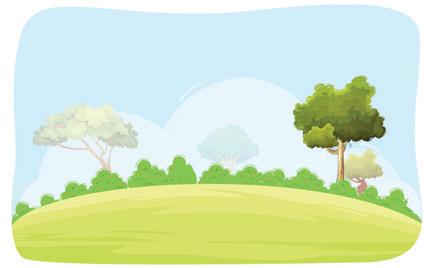





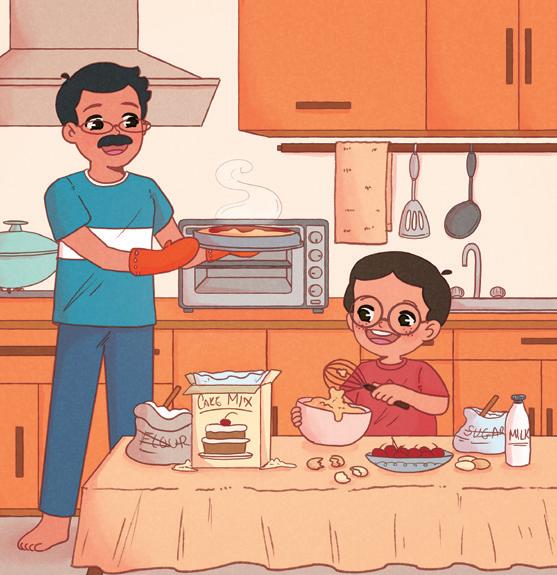

Circle Time
General Awareness
What Goes Together?
Parts of a Plant
General Awareness, page 67
Foundational Literacy Find Out Literacy Workbook, pages 37–38
Foundational Numeracy Far and Near Numeracy Workbook, page 36
DIY Story: Helping Hand
LO: Children will identify and name objects that are used together.
Rhymes and Stories, pages 35–39
Resources: Some common objects like toothbrush, socks, pen, spoon, bowl, cup, etc.
1. Warm-Up: Sit in a circle with children, if possible. Show one familiar item (e.g., a toothbrush) and say: This is a toothbrush. What do we use it with? Let children think and respond (e.g., toothpaste).
2. Think and Match: Show objects one by one to children. Ask: Can you find something that goes with this? Help children name the item and say what it goes with. Encourage children to give examples of other objects that are used together. For example: Show a pair of socks and ask: Can you find something that goes with this? Encourage the children to respond (shoes).


LO: Children will identify and match the parts of a plants with their names.
Resources: General Awareness, page 67; parts of plants brought by children
1. Recap: Recall the parts of plants by asking children to name them. Then call them one by one and ask them to show the different parts of the plant they collected as part of their homework.
2. Parts of a Plant: Write down names of parts of plants on the board (roots leaves, fruits, flowers, and stems). Point to each word and read them aloud and ask children to repeat after you.
3. Matching Parts of Plant: Ask children to open page 67 of the General Awareness book. Guide them to identify the parts of a plant and match them with the correct name.












LO: Children will identify the beginning sound and the first letters of a few objects.
Resources: Literacy Workbook, pages 37–38; A to Z letter flashcards (from Skillbook)
1. Identifying the First Letters: Give 2–3 letter flashcards randomly to each child. Say a word aloud, clearly stressing the beginning sound. For example: /t/ /t/ tomato. Ask: What sound does it begin with? Help children identify the first letter. The child who has the matching letter flashcard should hold it up. Repeat with other words and sounds.
2. Guess the Missing Letter: Call children one by one, say a word aloud and write its spelling on the board with the first letter missing. Guide children to identify the correct letter to fill in the blank. For example, say: Queen and write __ u e e n on the board.
3. Find Out: Ask children to open page 37 of the Workbook. Guide them to identify the pictures and fill in the blanks with the first letter. Then, ask them to open page 38 and solve only the first exercise where children have to identify the letter and circle the correct picture.





























Refer to page 37 of the Workbook. Look at the pictures and colour the correct letter.
LO: Children will identify objects that are far and near.
Resources: Numeracy Workbook, page 36; a ball
1. Understanding Far and Near: Call two children at a time. Give one child a ball and say: Place the ball near your friend. Then say: Now place the ball far from your friend. Guide the child if needed. Switch roles so both children get a turn to experience and understand the concepts of near and far. Ensure everyone gets a turn.
2. Far and Near: Ask children to open page 36 of the Workbook. First, guide them to identify the animal that is far from the pole and circle it. Then, guide children to draw a ball near the girl and a bat far from her.






If possible, take children to an open space and help them identify things that are far and near.
LO: Children will listen to and discuss the story Helping Hands. Resources: Rhymes and Stories, pages 35–39
1. Interactive Read Aloud: Read aloud the story Helping Hands with expressions and voice modulation. Pause in between to show pictures and ask questions like:
• What is the father making?
• What is the boy folding?
• Is the boy cleaning the car?
• Who cleans the house?
2. Helping Hand in School: Ask children to share ways in which they can help at school. Encourage them to give examples like: keeping toys properly, packing their school bags on time, throwing waste in the dustbin, etc. Ensure everyone gets a chance to share.


Circle Time
Treasure Basket Guessing
General Awareness Leaves
Foundational Literacy Letters Q, R, S and T
Foundational Numeracy In and Out
DIY Leaf Impressions
General Awareness, page 68
Story Cards – Q, R, S, T
Numeracy Skillbook, page 56
LO: Children will practise vocabulary and sensory exploration using common textures and shapes.
Resources: A covered basket or bag with 4–5 familiar objects (sponge, plastic spoon, soft cloth, small toy car, toothbrush)
1. Mystery Touch: Say: I have something hidden in this basket. Let’s see if we can guess without looking! Let one child feel the item (without seeing) and describe it: It’s soft, it’s hard, it feels round.
2. Guess and Tell: Call children one by one. Ask: What do you think it is? Encourage others to guess too. Then reveal and celebrate, for example: It’s a sponge! Once all items are revealed, show them again and ask: Which one feels rough? / Which one is used in the bathroom? Ensure each child gets a chance to participate in the activity.

LO: Children will identify and compare the shapes of different leaves.
Resources: General Awareness, page 68; a few leaves of different shapes and sizes (2 leaves per shape); a tray
1. Looking at the Leaves: Show the leaves and say: Leaves are green in colour. They are of different shapes and sizes. Place the leaves on a tray and pass the tray around. Let children observe the leaves of different shapes and sizes.
2. Matching Leaves: Lay the leaves neatly on a table. Call children one by one. Guide each child to select two leaves that look the same. Ensure everyone gets a turn.
3. Leaves: Ask children to open page 68 of the General Awareness book. Guide them to circle the leaf on the right that matches the one on the left.


























LO: Children will identify letters Q–T, listen to related stories and identify words starting with letters Q–T.
Resources: Story cards; letter flashcards (from Skillbook)
Introduction
1. Warm-Up: Call children one by one and give them a flashcard. Ask them to identify the letter and say two words that begin with that letter. Ensure everyone gets a turn.
Practice
2. Story Time: Show the pictures from the story card of letter Q and ask the children to name the objects starting with /kw/ sound (queen, quill, quilt, etc). Then read aloud the story emphasising the words starting with /kw/ sound and ask the children to repeat them after you. Finally, ask the children to underline the words starting with the letters Qq. Repeat the same for letters R, S and T.



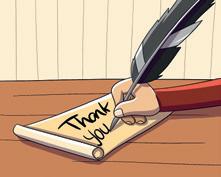

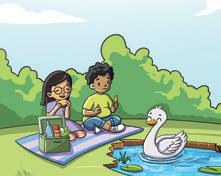
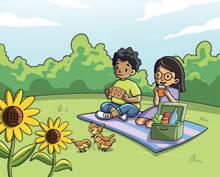





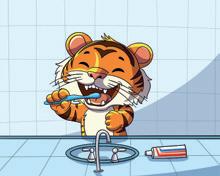



Refer to a page from a story book or a children’s magazine. Try to find words starting with Q, R, S and T and underline them.
LO: Children will identify the concept of in and out through a hands-on activity and by looking at pictures.
Resources: Numeracy Skillbook, page 56; a box; some toys
Introduction
1. Explaining In and Out: Place a few toys in a basket and say: Look, the toys are in the basket. Then take them out and say: Now the toys are out of the basket. Repeat slowly 3–4 times for reinforcement.
2. Activity Time: Call children one by one and give them toys or books. Say: Can you put your toy IN the basket? Then, Can you take it OUT? Ensure everyone gets a turn.
Practice
3. In and Out: Ask children to open page 56 of Skillbook. Guide them to identify the pictures showing in and out and read aloud the given sentences.











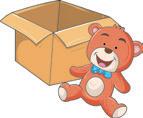
Give real-life examples for in and out like books in the bag / food in the tiffin box / pencils out of the pencil box / books out of the bag, etc.
LO: Children will observe leaf shapes and patterns while exploring textures through a fun art activity. Resources: Two leaves (per child); a drawing sheet; crayons
1. Set Up and Demonstration: Gather a few dry leaves of different shapes and sizes. Give each child a white sheet and a few crayons. Sit with the children and say: Let’s find out what’s hiding on this leaf! Place a leaf flat under the paper. Show how to gently rub the crayon sideways over the paper, and let the leaf’s pattern appear. Guide children to do the same.
2. Observation and Discussion: Let children try the activity with different leaves and crayon colours. Walk around and encourage them: Can you find a leaf with many lines? / Which leaf made the biggest pattern? Once done, display the leaf impressions and let children point out their favourite one.








Domain General Awareness
Learning Outcome Children will identify and name parts of a plant.
Resources General Awareness, page 65. Parts of plant – leaves, flowers, a fruit; roots of coriander or mint (if possible); 2–3 classroom objects like pencil, crayon and eraser; a basket
Suggested Method Mix the parts of plants and the objects in a basket. Call children one by one and ask them to identify and name the plant parts and put them inside the basket. Clap for each child and give them a smiley. Ensure everyone gets a turn.
Support for Struggling Learners
Gather the children in a circle and refer to page 65 of the General Awareness book. Point to the picture and help them identify the parts of the plants. Then, keep the parts of the plant (roots, leaves, flowers and a fruit) neatly on a table. Call children one by one and support them in naming each part.
Domain Foundational Literacy
Learning Outcome Children will identify the first sound and the first letter of objects beginning with the letters Q–T.
Resources Chalk; objects or pictures of letters starting with letters Q–T; Story cards
Suggested Method Write letters Q–T on the board in a random order. Say a word starting with one of these letters and ask the children to point to the correct letter the board. Clap and give a smiley or star to each child. Ensure everyone gets a turn.
Support for Struggling Learners
Gather the learners in a circle. Show them some objects or pictures of objects starting with letters Q–T and name them, emphasising on beginning sound. Ask the children to repeat after you. Repeat the same for pictures and/or words in the story cards of Q, R, S and T.
Domain Foundational Numeracy
Learning Outcome
Children will identify the objects that are near and far.
Resources A soft toy; classroom objects like books, bottle, pencil, etc.

Suggested Method
Support for Struggling Learners
Call children one by one. First, ask them to keep the soft toy near the box and then far from the box. Clap for each child and give them a smiley. Ensure everyone gets a turn.
Gather the learners together. First stand near a table and say: I am standing near the table, I can touch the table. Then stand far from the table and say: I am far from the table. Repeat the activity with other objects.



































Circle Time Fun with Exercises
General Awareness Flowers
Foundational Literacy Letter Uu
General Awareness, page 69
Literacy Skillbook, pages 56–57; Literacy Workbook, page 39
Foundational Numeracy Do and Learn Numeracy Skillbook, page 57
DIY Burst the Crackers
Art and Craft, pages 22–23
LO: Children will perform simple exercises to stretch their bodies and cool down.
1. Warm-Up: Say: Let us wake up our bodies. Guide them with simple standing stretches like reaching for the sky, bending to touch toes, and twisting side to side.
2. Fun with Exercises: Say: Now copy me! Lead slow movements like:
• March in place
• Swing your arms
• Stand tall like a tree
• Balance on one foot
Let each move last 5–10 seconds.
3. Cool Down: Ask children to close their eyes and take 3 deep breaths and say: Great job moving your body!

LO: Children will identify and name some common flowers. Resources: General Awareness, page 69; some flowers like marigold, rose, hibiscus, etc.
1. Warm-Up: Ask: Can you name some flowers that you know? Let children share their responses. Also, guide them to describe how the flowers look (e.g., its colour, shape and size).

2. Looking at Flowers: Show the flowers one by one to children, name them and help children identify their colours. Point and show the petals of each flower. Then, pass around the flowers and ask children to observe and feel them.


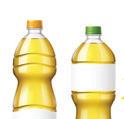


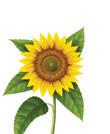


3. Flowers: Ask children to open page 69 of the General Awareness book. First, guide them to identify the names of the flowers. Point to each flower, say its name aloud and ask children to repeat after you. Then, ask children to circle the flowers that they have seen.









LO: Children will identify the symbol and sound of the letters Uu and write the letters.
Resources: Literacy Skillbook, pages 56–57; Literacy Workbook, page 39
1. Singing to Letters Uu: Introduce the rhyme on letters Uu with voice modulations and expressions. Repeat it at least 2–3 times, encouraging the children to join in.
Letter Uu Rhyme
u/ /u/ umbrella, keeps me dry, /u/ /u/ under, the clouds in the sky. /u/ /u/ up, where the birdies fly, Letter U says /u/, let’s all try!
2. Listening to /u/ Sound: Guide the children to open page 56 of the Skillbook. Point to each picture and say the word, emphasising the /u/ sound. For example: /u/ /u/ umpire OR /u/ /u/ umbrella.
3. Symbol Recognition of Letters Uu: Write capital U and small u on the board. Then, ask everyone to finger trace the letters in the air using their index fingers. Call children one by one to trace the letters on the board.
4. Writing Practice of Letters Uu: Guide the children to page 56 of the Skillbook. Ask them to trace the letters Uu carefully. Support those who need help.
5. Activity on Letters Uu: Ask children to open page 57 of the Skillbook. Guide them to draw a ball up the stairs and a boy under the umbrella.


















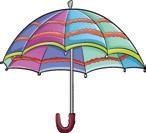
Refer to page 39 of the Workbook, trace and write the letters U and u.
LO: Children will identify the concept of in and out.
Resources: Numeracy Skillbook, page 57; in and out flashcard (from Skillbook); a pencil box; a ball and a box
1. Recap: Hand out the in and out flashcards to children. Recall the concept of in and out. Show a ball and put it inside a box and say: The ball is in the box. Then take it out and say: The ball is out of the box. Then ask children to hold up the flashcard showing in and out. Monitor and guide as required.
2. Fun with Pencil Box: Ask children to take out their pencil boxes. Then ask them to take out the pencil from the box and then put it back inside. Repeat several times for reinforcement.
3. Do and Learn: Recite the poem Going In and Out given on page 57 of the Skillbook, and ask children to recite along. Then ask children to solve page 57. First guide them to draw a ball in the box and a pencil outside the box. Then, ask children to circle the fruits that are outside the basket.










LO: Children will develop their fine motor skills by dipping the ear buds in paint and pasting them.
Resources: Art and Craft, pages 22–23; ear buds (12 per child); red, blue, yellow and orange colours
1. Warm-Up Discussion: Ask: When do we burst crackers? Listen to all responses. Then say: We burst crackers during special occasions and festivals like Diwali.
2. Making Colourful Earbuds: Give the earbuds to the children. Guide and demonstrate how to dip the ends of the earbuds in paint to make the tips colourful. Help them to dip the earbuds in one colour at a time.
Tip




Collect the ear buds and lay them on a paper. Let them dry and use them in the activity for the next session.

Domain
Circle Time
Topic of the Day Book & Page
Making Simple Choices
General Awareness Handprint Flowers
Foundational Literacy Letter Uu Literacy Skillbook, pages 56–57; Letter U Story Card
Foundational Numeracy In and Out Numeracy Workbook, page 37
DIY Burst the Crackers
Art and Craft, pages 22–23
LO: Children will develop their socio-emotional skills by practising decision-making in daily situations.
1. Setting the Idea: Greet the children warmly. Say: We all make choices. We choose what to eat, what to wear and what to play with. Let us all talk about our choices today! Use an expressive voice and simple hand gestures to keep the children engaged. Let them know that there are no right or wrong answers.
2. Making Choices: Hold up two fingers for visual support and say: Now I will give you two choices. You will tell me what you choose! Ask clear, simple questions one at a time. Let children raise their hands or point to show their choice. For example:
• Would you like to eat an apple or a banana?
• Would you wear a raincoat or a sweater when it rains?
• Would you play with blocks or puzzles?
• Would you visit a park or a zoo?
Pause after each question, give time for responses, and appreciate all answers.


LO: Children will develop their fine motor skills by making flowers using handprint impressions. Resources: Some real flowers; drawing sheet (1 per child); paint
1. Warm-Up Discussions: Begin by showing a real or paper flower (if available) and say: Flowers are beautiful! Today, we will make our own flower using our hands! Ask: What colours do you see in flowers? Let children answer freely.
2. Handprint Flower: Guide each child to dip their palm in paint and press it gently on the paper to make petals. Let them choose colours and do 4–5 handprints in a circle to form a flower. Then, ask them to use green paint to draw a stem and leaves below using their fingers. Assist those who need help.
Keep the paintings aside to dry and tell: We will put your flowers up for everyone to see!








LO: Children will practise saying a few words and listen to phonic stories with words that begin with the letters Uu.
Resources: Literacy Skillbook, pages 56–57; Letter U story card
1. Recalling Sound and Symbol of Letters Uu: Reinforce the sound of letters Uu by showing pictures from page 56 of the Skillbook, emphasising on the beginning sounds. For example, say: /u/ /u/ umpire OR /u/ /u/ up. Then, write letters U and u on the board and invite children to come and trace the letters.
2. Letters Uu: Read aloud the sentences given on page 57 of the Skillbook emphasising the words starting with /u/ sound. Ask the children to repeat the words after you and circle the words starting with U and u.
3. Picture Talk: Show the pictures from the story card and discuss them one by one. Ask:
Picture 1: What is the old man holding?
Picture 2: What is happening in the picture?
Picture 3: How does the umbrella look?
Picture 4: Where is the old man standing?
















4. Interactive Read Aloud: Read aloud the story of letters Uu from the story card with expressions and voice modulation. Ask children to repeat the words with /u/ sound from the story. Then, slowly read the sentences from the story one by one and ask children to repeat them after you. Discuss the story by asking questions like:
• Who is walking outside?
• What did Uncle Musty do when it started raining?
• What did the strong wind do?
• Where did Uncle Musty hide?





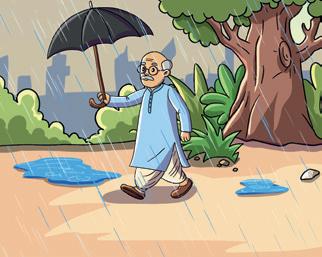
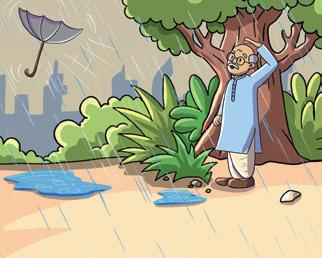

Find and circle the words that begin with the /u/ sound in the Letter Uu story card.
LO: Children will identify the concepts ‘in’ and ‘out’.
Resources: Numeracy Workbook, page 37; a chalk
1. In and Out Game: Draw a circle on the floor. Call children one by one. When you say In, ask the child to jump inside the circle and when you say Out, the child has to stand outside. Mix up the commands to make it interesting. Ensure everyone gets a turn.
2. In and Out: Ask children to open page 37 of the Workbook. Help them identify the objects that are ‘in’ and ‘out’ from the pictures given. Then, guide them to circle the objects that are out.






LO: Children will develop their fine motor skills by pasting the earbuds to make firecrackers.
Resources: Art and Craft, pages 22–23; coloured earbuds from the previous session; glue
1. Warm-Up: Say: Have you heard loud sounds and seen colourful lights in the sky during festivals? Those are firecrackers! Firecrackers make loud sounds—like Boom! Pop! Bang! Ask children to clap or stomp to copy the sounds




2. Burst the Crackers: Give the coloured earbuds to children. Ensure each child gets earbuds of four different colours. Guide them to paste the earbuds to make firecrackers.
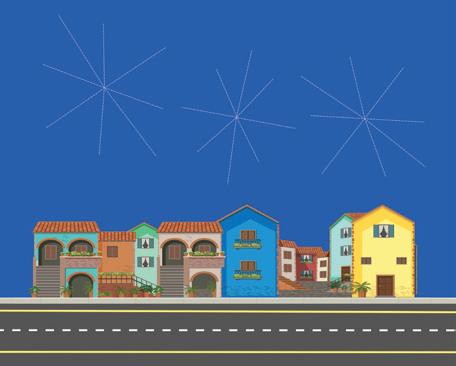
Circle Time
General Awareness
Framing Simple Questions
Colour Pink
General Awareness, page 70
Foundational Literacy Let’s Talk: Fun at the Fair Literacy Skillbook, pages 58–59
Foundational Numeracy On and Under Numeracy Skillbook, page 58
DIY
More About Grouping
LO: Children will learn to frame and ask simple questions.
STEM Exploration, pages 22–23
1. Warm-Up: Say: Questions help us learn about each other! A question often starts with words like ‘what’, ‘who’, or ‘where’. Model a question, say: What’s your favourite food? Then answer yourself with the expression: I like rice! Repeat once more with another question: Who is your friend? I will say: My friend is Shweta.
2. Framing Simple Questions: Say: Now it’s your turn! Let’s go around and each of you will ask a question to the friend sitting beside you. Guide them gently. If needed, whisper a question in their ear or give prompts. Sample questions they can use:
• What do you like to play with?
• Where do you sleep at home?
• Who is your friend?
• What is your favourite colour?
Let the child ask a question to a friend and encourage them to respond with a short answer.

LO: Children will identify objects that are pink in colour.
Resources: General Awareness, page 70; some pink colour objects; pink crayon; objects of other colours; a basket
1. Warm-Up: Show a pink colour object to children and say: This is pink colour. Then, ask children to take out their crayon sets and ask them to identify pink colour crayons.

2. Spotting Pink Colour: Keep the pink colour objects and objects of other colours in a basket. Call children one by one and ask them to identify and pick objects that are pink in colour. Ensure everyone gets a turn.
3. Colour Pink: Ask children to open page 70 of the General Awareness book. Say: Look at this lotus. It is a flower. It is pink in colour. Then ask them to colour the lotus using a pink crayon.








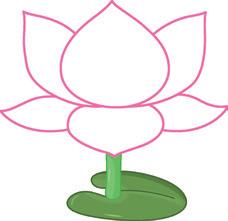

LO: Children will discuss a picture on The Fun at the Fair and share about their experience.
Resources: Literacy Skillbook, pages 58–59
Introduction
1. Warm-Up Discussion: Say: Have you ever been to a fair or a mela? Pause for a moment and welcome all responses. Then, say: It’s a place full of fun! Let’s imagine we’re going to one! Use expressive voice and gestures: We see big colourful balloons, a giant wheel going round and round, people selling yummy food, and games to play!
2. Talking and Sharing: Ask questions to prompt thinking:
• What would you like to eat at the fair?
• What rides would you go on?
• Would you go with your family or friends?
Let children raise hands and share—even one-word answers are fine.
Practice
3. Fun at the Fair: Ask children to open pages 58–59 of Literacy Skillbook. Ask them to observe the pictures and discuss what they see. Ask questions like:
• What shops do you see in the picture?
• Who is buying an ice-cream?
• Who is ringing a bell?
• What ride do you see?
Point to each picture as you discuss them. Make sure each child participates and gives responses.
LO: Children will identify the concept of on and under.




Resources: Numeracy Skillbook, page 58; a ball; a table; a chair; a soft toy
1. Explaining On and Under: Keep a ball on the table and ask: Where is the ball? Listen to all responses, and say: The ball is on the table. Then keep the ball under the table and ask: Now where is the ball? Let children respond and then say: The ball is under the table.
2. Hands-on Activity: Call children one by one. Guide them to place the soft toy on the chair and then under the chair. Ensure everyone gets a turn.
3. On and Under: Ask children to open page 58 of the Skillbook. Guide them to identify the concept of on and under from the pictures. Then read aloud the sentences given on page 58.





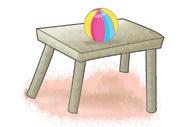
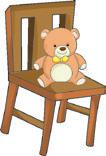





Observe different objects at home, things that are kept on table, cupboard, etc. and things that are kept under.
LO: Children will group objects based on colours, shapes and sizes. Resources: STEM Exploration, pages 22–23; buttons of different colours, shapes and sizes; 3 trays
1. Warm-Up: Say: Look at these buttons! They are all different. Let’s see how we can put them in groups. Place a variety of buttons (different colours, sizes, shapes) in a shallow bowl or tray.
2. Sorting Time: Give each child a small mat or paper plate. Ask them to sort the buttons in one clear way:
• Option 1: By colour (e.g., all red buttons together)
• Option 2: By size (big vs. small)
• Option 3: By number of holes (2-hole vs. 4-hole buttons) Say: Can you find all the red buttons?/ Put the small buttons in the tray.
Start with one sorting rule at a time. Guide and encourage observation.

Bring a 6-section egg carton or a similar container to school for the next session.

Domain
Circle Time Gratitude
Topic of the Day
General Awareness Colour Purple
Book & Page
General Awareness, page 70
Foundational Literacy Let’s Talk: Fun at the Fair Literacy Skillbook, pages 58–59
Foundational Numeracy On and Under Numeracy Workbook, page 38
DIY More about Grouping
LO: Children will listen to a story on gratitude and discuss it.
1. Warm-Up: Gather children in a circle, if possible. Say: Gratitude means saying thank you when someone helps us. Today, let’s listen to a story about it.
2. Story Time: Narrate the story The Thankful Little Ant with expressions and voice modulation. Discuss the story by asking questions like:
• Where was the ant stuck?
• Who dropped a leaf near the puddle?
• Who was caught in the net?
STEM Exploration, pages 22–23
The Thankful Little Ant
Once, a little ant was walking and got stuck in a puddle. A bird saw it and dropped a leaf near the puddle. The ant climbed on the leaf and reached home safely. The next day, the ant saw the bird caught in a net. The ant quickly bit the rope, and the bird flew away. They both said, “Thank you!” and became good friends.
3. Sharing Time: Ask: When do you say thank you? Let each child share one moment when they felt happy because someone helped them. End by saying: Saying thank you makes everyone feel good!

LO: Children will identify objects that are purple in colour.
Resources: General Awareness, page 70; purple objects; crayon set; a brinjal (if possible); objects of other colours; a basket
1. Warm-Up: Show a purple colour object to the children and say: This is purple colour. Then, ask children to take out their crayon sets and ask them to identify purple crayons.
2. Spotting Purple Colour: Keep the purple colour objects and objects of other colours in a basket. Call children one by one and ask them to identify and pick objects that are purple in colour. Ensure everyone gets a turn.
3. Purple Colour: Ask children to open page 70 of the General Awareness book. Say: Look at this brinjal. It is a vegetable. It is purple in colour. Then ask them to colour the brinjal using a purple crayon. Show children a purple brinjal, if available.







LO: Children will identify and name the different things we see in a fair.
Resources: Literacy Skillbook, pages 58–59



1. Warm-Up: Say: Today, we are going to the fair! What do we see there? Encourage responses: Do we see giant wheels? Balloons? Candy? Games? Use expressive voice and hand actions (like spinning hands for the giant wheel or pretend eating).
2. Pretend Movements: Guide the children in imaginary rides. Say: Hold your pretend ticket. Let’s sit on the giant wheel—going up, up, up! (Stretch up) Let’s ride the merry-go-round—round and round! (Spin slowly on the spot). Let’s walk to the food stall—what would you like? Popcorn? Ice-cream? (Let them respond).
3. Fun at the Fair: Ask children to open pages 58–59 of the Skillbook. Point to each picture and help them identify the objects one by one. For example, point and say: Giant Wheel and ask children to repeat after you. Repeat each word 3–4 times.
4. Finding Picture: Ask children to observe the picture given on pages 58–59. Ask them questions like:
• Can you find the /p/ /p/ popcorn seller?
• Can you find the /b/ /b/ balloons? Let children find and point to the correct picture.
LO: Children will identify the concept of on and under.




Resources: Numeracy Workbook, page 38; a soft toy; a table or chair

1. Recalling On and Under: Call children one by one. Place the soft toy either on the table or under the table. Let children identify whether the soft toy is on or under. Ensure everyone gets a turn.
2. On and Under: Ask children to open page 38 of the Workbook. Help them to solve the activity as per the given instructions. Monitor and guide as required.
LO: Children will sort buttons according to colours, sizes and shapes.
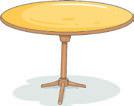







Resources: STEM Exploration, pages 22–23; buttons of different colours sizes and shapes; 6-section egg carton or a similar container (brought by children); glue
1. Setting Up: Glue the buttons on the egg tray as explained on page 22. After setting the tray, show and explain how to sort the buttons based on colours, shapes and sizes.
2. Sorting and Grouping: Call children one by one. Guide them to sort and group the objects as per the given instructions on pages 22 and 23. Ensure everyone gets a turn.

1.
2.
Let’s

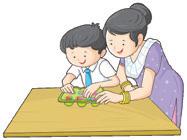







Domain General Awareness
Learning Outcome Children will identify pink and purple colour objects.
Resources Objects of different colours including pink and purple colour; a basket
Suggested Method Mix all the objects and keep them in a basket. Call children one by one. Ask them to identify and pick a pink object first and then a purple object. Clap for each child and give them a smiley. Ensure everyone gets a turn.
Support for Struggling Learners
Domain
Gather the learners together. Show them a pink colour object and say: This is pink in colour. Then, help them identify different objects from the surroundings that are pink in colour. Repeat the same for the purple objects.
Foundational Literacy
Learning Outcome Children will connect the sounds and symbols of letters Uu, and say common words starting with letters Uu.
Resources Literacy Skillbook, page 56; letter U story card
Suggested Method Write letter U on the board, call children one by one to trace the letter with chalk and say aloud two words starting with /u/ sound. Finally, use the story card to read the story aloud while emphasising the words that start with the /u/ sound. Ask the children to repeat these words after you.
Support for Struggling Learners
Domain
Gather the learners in a circle. Show them pictures starting with the /u/ sound from page 56 of Skillbook. For example, say: /u/ /u/ umpire and ask the children to repeat after you. Repeat the same for pictures and words in the story card. Then write letters U and u on the board, call the children one by one and ask them to trace the letters with chalk.
Foundational Numeracy
Learning Outcome Children will identify the concept of in and out.
Resources Flashcards with ‘in’ and ‘out’ concept (from Skillbook); a ball and a box

Suggested Method Call children one by one. First, ask them to keep the ball in the box and then outside the box. Clap for each child and give them a smiley. Ensure everyone gets a turn.
Support for Struggling Learners
Gather the learners together and give the ‘in and out’ flashcards from the Skillbook. Explain the concept of ‘in and out’ to children by putting the ball in a box and then out of a box. Then, guide children to hold up the flashcard showing in and out one by one. Ask: Can you show me the picture where the pencil is in / out of the box?




































Domain
Topic of the Day Book & Page
Circle Time Who is Missing?
General Awareness Importance of Fruits
Foundational Literacy Letter Vv Literacy Skillbook, pages 60–61; Literacy Workbook, page 40
Foundational Numeracy Story: The Worm and the Bird Numeracy Skillbook, page 59
DIY Mystery Fruit Bag
LO: Children will enhance their observation and memory skills by identifying which classmate is missing from the group.
1. Warm-Up: Gather the children in a circle, if possible, or ask them to sit down properly in their places. Say: Look around. Remember who is sitting with you. Let them observe for a few seconds.
2. Who is Missing?: Ask children to close their eyes. Then, ask one child to quietly hide behind a chair or step out with the help of an adult.
Say: Now open your eyes—who is missing?
Let children guess. Repeat the activity with a different child each time for reinforcement.


LO: Children will identify, name and understand how fruits help us stay strong and healthy. Resources: Some common fruits like apple, orange, mango, banana, guava, grapes, etc.
1. Show and Talk: Gather a few real fruits (or plastic/toy fruits if real ones aren’t available). Say: Let us look at some yummy fruits today! Hold up each fruit one by one, say its name clearly, and let children repeat.
Example: This is a banana. Say banana! Let them touch or hold the fruit if possible.
Ask questions like:
• What colour is this fruit?
• Have you eaten this before?
• Is it soft or hard?
2. Importance of Fruits: Say: Fruits keep us strong and healthy! Use simple statements to help children understand:
• Apples are good for your tummy.
• Bananas give you energy.
• Oranges help you stay well when you have a cold.








1. Singing to Letters Vv: Introduce the letters Vv with a rhyme. Repeat it at least 2–3 times, encouraging the children to join in.

Letter Vv Rhyme


































LO: Children will identify the symbol and sound of the letters Vv and write the letters. Resources: Literacy Skillbook, pages 60–61; Literacy Workbook, page 40






3. Symbol Recognition of Letters Vv: Write capital V and small v on the board. Ask children to trace them in the air with their index fingers, then take turns tracing on the board.
4. Writing Letters Vv: Guide the children to page 60 of the Skillbook. Ask them to trace the letters Vv carefully. Support those who need help.
5. Activity on Letters Vv: Ask children to open page 61 of the Skillbook. Guide children to draw lines connecting vegetables to the vegetable basket.












LO: Children will recall the concept of ‘on’ and ‘under’ through a story. Resources: Numeracy Skillbook, page 59; a bottle; a table or a chair

Refer to page 40 of the Workbook. Trace and write the letters V and v.















































/v/ /v/ van goes vroom, /v/ /v/ vase holds flowers in bloom. /v/ /v/ vegetables are good to eat, Letter V is really neat!
2. Listening to /v/ Sounds: Guide the children to page 60 of the Skillbook. Point to each picture and say the word, emphasising the /v/ sound. For example: /v/ /v/ vase OR /v/ /v/ van





1. Recall: Call children one by one and give them the following instructions:
• Keep the bottle on the table.
• Keep the bottle under the table.
Monitor and guide the children as required.
Ask children to observe the classroom and identify the things kept on something or under something.
2. Picture Talk: Ask children to open page 59 of the Skillbook. Help them identify the pictures showing the worm on the leaf and under the leaf.
3. Interactive Read Aloud: Read aloud the story The Worm and the Bird with expressions and voice modulation. Pause in between to show relevant pictures and ask questions like:
• Who is sleeping on the leaf?
• Who tries to eat the worm?
• Where did the worm hide?
• What did the bird do when it could not see the worm?






LO: Children will identify, name the fruits and explore them using senses (touch, smell, sight).




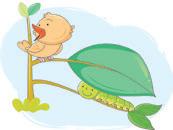

Resources: A cloth bag or basket; 3–5 real fruits (e.g., banana, apple, orange, guava, pomegranate); blindfold or scarf
1. Setting the Context: Say: We have some fruits hidden in this basket! Let’s find out what they are—but not with our eyes! Show the basket briefly and then cover it.
2. Guess the Fruit: Call one child at a time. Blindfold the child (or ask them to close their eyes). Let them feel or gently smell a fruit. Ask: Can you guess what fruit this is? If they guess correctly, everyone claps. If not, guide them gently by giving hints (e.g., It is red and round. It starts with the letter A).
Domain
Circle Time
Tying a Knot
General Awareness Pomegranate
General Awareness, page 72
Foundational Literacy Letter Vv Literacy Skillbook, pages 60–61; Letter V Story Card
Foundational Numeracy Up and Down Numeracy Skillbook, page 60
DIY Rhyme: Jack and Jill Rhymes and Stories, page 40
LO: Children will learn to tie a simple knot, enhancing their fine motor skills.
Resources: A strip of ribbon (1 per child)
1. Warm-Up: Say: Today we will learn how to tie a simple knot! Like when we tie a gift or our shoelace. Demonstrate step-by-step:
• Hold both ends of the ribbon.
• Cross one end over the other.
• Tuck one end under and pull both ends tight. Do it slowly and repeat 2–3 times.
2. Tying a Knot: Hand out the ribbons to children and ask them to tie a knot. Move around to guide them. Clap and encourage their efforts.

LO: Children will recognise and name the fruit pomegranate and make fingerprints on it.
Resources: General Awareness, page 72; red paint; a pomegranate
Introduction
1. Warm-Up: Say: Today we will talk about a fruit that has many tiny red seeds inside. It is called pomegranate! Show a real pomegranate (whole and/or cut). Let children observe closely. Say: Can you say pomegranate?
2. About a Pomegranate: Say: Pomegranate is red outside and has juicy red seeds inside. We do not bite it like an apple; we cut it and eat the small seeds. Ask: Have you eaten pomegranate before? / Is it sweet or sour?

3. Fruits: Ask children to refer to page 72 of the General Awareness book. Show the picture of a pomegranate. Guide children to dip their fingers in red paint and make fingerprints to colour the pomegranate.















LO: Children will practise saying aloud a few words and listen to phonic stories with words that begin with letters Vv.
Resources: Literacy Skillbook, pages 60–61; Letter V story card
1. Recalling Sound and Symbols of Letters Vv: Reinforce the sound of letters Vv by showing pictures from page 60 of the Skillbook, emphasising the beginning sounds For example, say: /v/ /v/ vase. Then, write letters V and v on the board and invite children to come and trace the letters.
2. Letters Vv: Read aloud the sentences given on page 61 of the Skillbook emphasising the words starting with /v/ sound. Ask the children to repeat the words after you and circle the words starting with V and v.
3. Picture Talk: Show the pictures from the story card and discuss them one by one. Ask:
Picture 1: What is the girl driving?
Picture 2: What bird can you see?
Picture 3: What do you see in this picture?
Picture 4: What is the girl playing?








4. Interactive Read Aloud: Read aloud the story of letters Vv from the story card with expressions and voice modulation. Ask children to repeat the words with /v/ sound from the story. Then, slowly read the sentences from the story one by one and ask children to repeat them after you. Discuss the story by asking questions like: Who is driving the van? / Where is the vulture? / Who plays the violin?








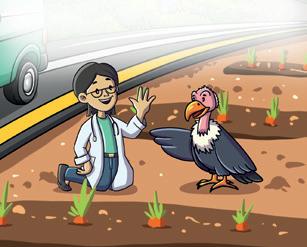
Find and circle the words that begin with /v/ sound in the story card of letters Vv.






LO: Children will identify the concepts ‘up’ and ‘down’ through movement and observation.
Resources: Numeracy Skillbook, page 60; an inflated balloon
1. Warm-Up: Say: Today we will learn two fun words—UP and DOWN! Do the action as you say each word: “UP!” (Raise both hands high) and “DOWN!” (Bring hands low or touch the floor)
Repeat a few times with different body parts:
• Hands up… hands down
• Shoulders up… shoulders down
• Stand up… sit down
2. Balloon Activity: Toss the balloon gently in the air. Say: Look! The balloon is going UP! Let it fall. Say: Now it is coming DOWN! Repeat with turns. Let children toss the balloon in pairs or small groups.
3. Up and Down: Ask children to open page 60 of the Skillbook. Guide them to identify up and down from the given pictures. Read aloud the sentences given on the page.
Help children identify the objects that are up and the ones that are down. For example: fan (up); bags (down)
LO: Children will recite the rhyme Jack and Jill with actions and expressions.
Resources: Rhymes and Stories, page 40
1. Rhyme Time: Recite the rhyme Jack and Jill with actions and expressions and ask children to sing along. Repeat 3–4 times to help children learn the song.
2. Sequencing the Rhyme: Ask simple questions:
• Who went up the hill?
• What did they want to get?
• What happened to Jack?
Encourage each child to participate and give responses. Help them understand the sequence of the rhyme.








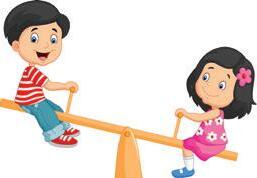



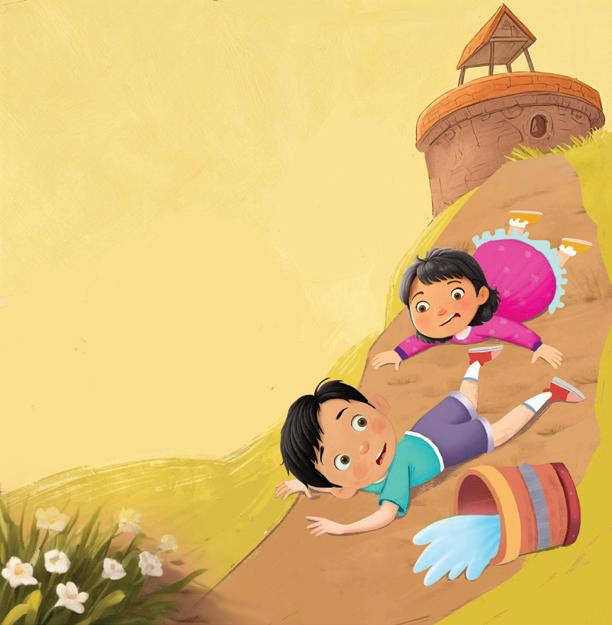


Circle Time At the Zoo
General Awareness Fruits
General Awareness, pages 72–74
Foundational Literacy Letter Ww Literacy Skillbook, pages 62–63; Literacy Workbook, page 41
Foundational Numeracy Do and Learn Numeracy Skillbook, page 61
DIY Rhyme: Jack and Jill Rhymes and Stories, page 40
LO: Children will recall, identify and name animals through imaginative play and guided discussion.
1. Warm-Up: Greet the children warmly. Ask: Have you ever been to a zoo? What did you see there? Listen to all responses. Say: Let us go on a pretend trip to the zoo! Close your eyes and imagine animals.
2. Pretend Walkthrough: Pretend to walk through a zoo. Give them cues and ask questions like:
• Look! I see something tall with a long neck! (Children guess: giraffe)
• What’s that sound? Roar! Which animal is that?
Ask: What animals would you love to see? Can you describe them?

LO: Children will recognise and name some common fruits and write their first letters. Resources: General Awareness, pages 72–74; different fruits (real or pictures) of red, green and yellow colour
1. Colour Sorting: Say: Let us look at fruits of different colours today! Use real or pretend fruits:
• Red – Apple, Strawberry
• Green – Guava, Grapes
• Yellow – Banana, Mango
Show one fruit at a time. Say: This is an apple. It is red. Can you say apple? Repeat for each fruit and colour.










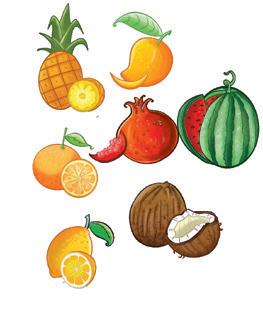




2. Beginning Sound of Fruits: As you name each fruit, say the beginning sound: /a/ /a/ apple, /g/ /g/ grapes! Encourage children to repeat after you.
3. Eating Habits: Say the steps of eating a fruit slowly with actions and ask children to follow:
• Wash the fruit (pretend washing)
• Eat the fruit (pretend eating)
• Throw peels in the dustbin (point and show the dustbin in class)
• Wash your hands (pretend washing hands)
4. Fruits: Refer to pages 72–74 of General Awareness book. Guide children to solve the pages as per the given instructions. Assist those who need help.







Resources: Literacy Skillbook, pages 62–63; Literacy Workbook, page 41







LO: Children will identify the symbol and sound of the letters Ww and write the letters.
1. Singing to Letters Ww: Introduce the letters Ww with a rhyme. Repeat it at least 2–3 times, encouraging the children to join in.
2. Listening to /w/ Sounds: Guide the children to page 62 of the Skillbook. Point to each picture and say the word, emphasising the /w/ sound. For example: /w/ /w/ wall OR /w/ /w/ watch.
Letter Ww Rhyme /w/ /w/ watermelon, juicy and sweet, Wiggle and wobble, tap your feet! /w/ /w/ window, wide and bright, Waves to the world, morning light!
3. Symbol Recognition of Letters Ww: Write capital W and small w on the board. Then, ask everyone to finger trace the letters in the air using their index fingers. Call children one by one to trace the letters on the board.

4. Writing Letters Ww: Guide the children to page 62 of the Skillbook. Ask them to trace the letters Ww carefully. Support those who need help.




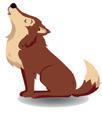
5. Activity on Letters Ww: Ask children to open page 63 of the Skillbook. Guide children to say /w/ /w/ window. Then ask them to colour the window and count the number of windows. Refer to page 41 of the Workbook, trace and write the letters W and w.










LO: Children will identify the concept of ‘up’ and ‘down’ through movement and observation.
Resources: Numeracy Skillbook, page 61
1. Fun with Movement: Say: Let us play the following game! Give instructions with actions like:
• Jump UP!
• Touch the ground – that’s DOWN!
• Reach UP to the sky!
• Crouch DOWN like a frog!
Do this as a group for 1–2 minutes to reinforce the concept in a fun way.
2. Do and Learn: Ask children to open page 61 of the Skillbook. Guide them to circle the pictures that show ‘up’ and tick the ones that show ‘down’.
LO: Children will recite the rhyme Jack and Jill and play a fun game.





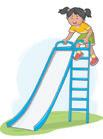
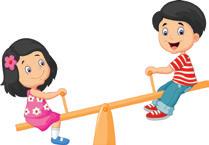




Resources: Rhymes and Stories, page 40; 2 empty buckets; chalks or tapes; a cone-shaped object (hat; play cone, etc.)
1. Rhyme Time: Recite the rhyme Jack and Jill with actions and expressions and ask the children to recite along. Repeat 3–4 times to help them remember the rhyme.
2. Hill Race: Create a small path in class or outdoors using tape or chalks to mark a hill trail. Two children pretend to be Jack and Jill. They walk up the path holding an empty bucket. At the end of the path, they touch a cone (the “hilltop”), and return. Everyone gets a turn.



If a cone-shaped object is not available. Keep a soft toy or a ball and ask children to touch that.
Circle Time
General Awareness
Spot the Difference
Matching Fruits
General Awareness, page 75
Foundational Literacy Letter Ww Literacy Skillbook, pages 62–63; Letter W Story Card
Foundational Numeracy Up and Down Numeracy Workbook, page 39
DIY Fruit Part
LO: Children will observe a few items and try to spot the similarities and differences.
Resources: A few common classroom items—like two different spoons, crayons, books, shoes, cups, etc.
1. Warm-Up: Gather the children in a circle, if possible. Say: Let us look closely at some things and find out what is the same and what is different!
2. Spotting the Similarities and Differences: Place two objects in front of the children (e.g., one red crayon and one blue crayon). Ask: What do you see? Are these the same or different? Continue with different pairs like: Two socks (same colour but different patterns) / Two cups (look the same but different colours).
3. Finding Pairs: Call children one by one. Ask children to find two similar or different things in the classroom and bring them. Let them explain what is the same and what is the difference. Help if needed.

LO: Children will identify the fruits and match them to their correct halves.
Resources: General Awareness, page 75; half pieces of some fruits (both the halves)
1. Fruit Quiz: Say: Let us see how much we remember about fruits! Ask simple, clear questions one at a time. Let children raise their hands or answer together. Sample questions:
• Which fruit is yellow and long? (Banana)
• Which fruit has tiny red seeds inside? (Pomegranate)
• Which fruit is red and crunchy? (Apple)
• Which fruit is green outside and red inside? (Watermelon)
• Which fruit is small and purple or green? (Grapes)

2. Matching Halves: Bring a few fruits cut in half (each fruit should have 2 matching halves, e.g., apple left half and apple right half). Say: These fruits are in halves. Can you find the two that go together? Place halves in a mixed pile on the table. Call 2–3 children at a time to come and match halves to make a full fruit—2 halves of apples to make a whole Help children name the fruit after matching. Say: You made a full apple! Great job!
3. Matching Fruits: Ask children to open page 75 of the General Awareness book. Guide them to identify the fruits and match each fruit with the correct halves.


















LO: Children will practise saying aloud a few words and listen to phonic stories with words that begin with letters Ww.
Resources: Literacy Skillbook, pages 62–63; Letter W story card
1. Recalling Symbol and Sound of Letters Ww: Reinforce the sound of letters Ww by showing pictures from page 62 of the Skillbook, emphasising the beginning sounds. For example, say: /w/ /w/ wall. Then, write letters W and w on the board and invite children to come and trace the letters.









2. Letters Ww: Read aloud the sentences given on page 63 of the Skillbook emphasising the words starting with /w/ sound. Ask the children to repeat the words after you and circle the words starting with W and w.
3. Picture Talk: Show the pictures from the story card and discuss them one by one. Ask:
Picture 1: What animal do you see?
Picture 2: What is the man doing?
Picture 3: What is the man giving the wolf?
Picture 4: What is the wolf doing?





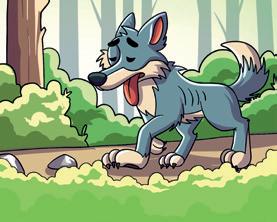



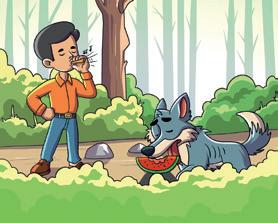
4. Interactive Read Aloud: Read aloud the story of letters Ww from the story card with expressions and voice modulation. Ask children to repeat the words with /w/ sound from the story. Then, slowly read the sentences from the story one by one and ask children to repeat them after you. Discuss the story by asking questions like: Who was walking in the forest? / Who did the wolf meet? / What did the man give the wolf to eat? / What did the wolf eat?
Find and circle the words starting with /w/ sound in the story card of letters Ww.
LO: Children will identify the concept of ‘up’ and ‘down’ through hands-on experience.
Resources: Numeracy Workbook, page 39; a bottle; a chair
1. Fun with Movement: Ask children to point up when you say Up and point down on the floor when you say Down. Mix up the commands to make it fun and engaging. Repeat it several times.
2. Placing the Bottle: Call children one by one. Ask them to place the bottle up (on the chair) and then down (on the floor). Guide children, if they need help. Ensure everyone gets a turn.
3. Up and Down: Ask children to open page 39 of the Workbook. Guide them to identify and circle the children who are up.

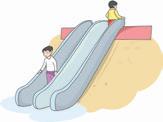




LO: Children will make a fruit salad to enjoy a fruit party while practising naming and describing fruits. Resources: Pre-cut fruits (apples, pomegranate, guava, etc.) in separate bowls; lemon; salt; a big bowl; a big spoon; paper plates and spoons (1 per child)
1. Meet the Fruits: Sit in a circle and place all bowls of cut fruit in the centre. Say: Look at all these fruits! Let’s name them together. Hold up each bowl and ask: What is this fruit called? What colour is it? Let children respond. Ensure that the fruits are washed and cleaned properly. Ensure that they are pre cut.
2. Making the Salad: Invite children in small groups to come and help the teacher make the fruit salad. Say: Let’s take turns to put some fruit in this big bowl. Each child adds a spoonful of fruit. Once all fruits are added, add some salt and lemon and mix gently with a big spoon. Say: Yay! We all helped make this fruit salad!
3. Taste and Talk: Give each child a small portion of fruit salad on a paper plate. Encourage them to eat and talk: Which fruit did you like the most? Use simple questions like: Was it sweet? / Was it soft or crunchy?







































After eating, guide them to clean up, wash, dispose of their plates and spoons in the dustbin and wash their hands.









Domain General Awareness
Learning Outcome
Children will identify different fruits and discuss the steps to eat fruits.
Resources A soft toy; real or pictures of fruits of red, green and yellow colour
Suggested Method Pass around a soft toy. The child holding the soft toy shares the name of a fruit and mentions its colour. Then guide children to enact and explain the different steps to eat a fruit—wash the fruit, eat it, wash hands. Clap for each child and ensure everyone gets a turn.
Support for Struggling Learners
Gather the learners together. Show them some common fruits of green, red and yellow colour and name them. Ask children to say aloud the names of those fruits. Also, mention names of other fruits of the same colour. Then, enact and show the steps involved in eating fruits in a sequence and let children follow.
Domain Foundational Literacy
Learning Outcome Children will connect the sounds and symbols of Vv and Ww, and say common words starting with letters Vv and Ww.
Resources Literacy Skillbook, pages 60–64; letters Vv and Ww story cards
Suggested Method Write letters Vv on the board, call children one by one to trace the letters with chalk and say aloud two words starting with /v/ sound. Finally, use the story card to read the story aloud while emphasising the words that start with the /v/ sound. Ask the children to repeat these words after you. Repeat the same for letters Ww.
Support for Struggling Learners
Gather the learners in a circle. Show them pictures starting with the /v/ sound from page 60 of Skillbook. For example, say: /v /v/ vase and ask the children to repeat after you. Repeat the same for pictures and words in the story card. Then write letters V and v on the board, call the children one by one and ask them to trace the letters with chalk. Repeat the same for letters Ww.
Domain Foundational Numeracy

Learning Outcome Children will identify the concept of up and down.
Resources A balloon
Suggested Method Call children one by one and give them a balloon. When you say up ask children to throw the balloon up and when you say down, ask children to put the balloon down on the floor. Clap for each child and ensure everyone gets a turn.
Support for Struggling Learners
Gather the learners together. When you say up ask them to point up and when you say down, ask them to sit down. Repeat 4–5 times for reinforcement. Then, point to the fan and say: The fan is up. Point to a table / chair and say: The table is down. Give examples of other objects that are up and down from the surroundings.



































Circle Time
General Awareness
Snowball Game
Colour Brown
Foundational Literacy Letter Xx
Foundational Numeracy Front and Back
DIY Light and Shadow
General Awareness, page 76
Literacy Skillbook, pages 64-65; Literacy Workbook, page 42
STEM Exploration, pages 24-26
LO: Children will listen and express themselves in a fun and engaging way.
Resources: One crumpled newspaper formed into a paper ball
1. Introduction: Let children sit in a circle, if possible. Say cheerfully: We are going to play a game with a pretend snowball today! When the snowball comes to you, you will tell us your name and one thing that you like. (Use gestures and a cheerful tone to hold their attention.)
2. Modelling: Hold the paper snowball and ask the children to watch you first. Say: I am Asha and I like colouring pictures! Add expressive voice and hand movements to keep it engaging. Then pass the ball.
3. Passing the Snowball: Pass the snowball to the next child. Encourage them to say: I am [child’s name]! I like ___________. If they are confident, prompt them gently: Do you want to say what you like? Help shy or quiet children by giving them options: Do you like bananas or apples? / Do you like cars or dolls? Make sure each child gets a chance to participate.

LO: Children will identify and colour the objects that are brown in colour.
Resources: General Awareness, page 76; some brown coloured objects and objects of different colours; a basket; crayons; a potato
Introduction
1. Warm-Up: Show a brown colour object to children and ask: Do you know what colour this is? Listen to all responses and say: This is brown colour.
2. Spot Colour Brown: Mix all the objects in a basket. Call children one by one and let them identify and pick any two brown objects.

3. Colour Brown: Guide children to identify brown colour from their crayon sets. Then, ask them to open page 76 of the General Awareness book and colour the potato with a brown crayon. Show them a real potato as well.





Help children identify brown colour objects around them.



LO: Children will identify the symbol and sound of the letters Xx and write the letters.
Resources: Literacy Skillbook, pages 64–65; Literacy Workbook, page 42
1. Singing to Letters Xx: Introduce the letters Xx with a rhyme. Repeat it at least 2–3 times, encouraging the children to join in.
2. Listening to /ks/ Sounds: Guide the children to page 64 of the Skillbook. Point to each picture and say the word, emphasising the /ks/ sound. For example: /ks/ /ks/ fox.




Letter X Rhyme /ks/ /ks/ fox, Hopped into a box. He tried to fix A spoon and mix, Then counted one to /ks/ /ks/ six!
3. Symbol Recognition of Letters Xx: Write capital X and small x on the board. Then, ask everyone to finger trace the letters in the air using their index fingers. Call children one by one to trace the letters on the board.
4. Writing Practice of Letters Xx: Guide the children to page 64 of the Skillbook. Ask them to trace the letters Xx carefully. Support those who need help.
5. Activity on Letters Xx: Ask children to open page 65 of the Skillbook. Guide them to circle the pictures that have the sound of /ks/.






















Refer to page 42 of the Workbook, trace and write the letters X and x.
LO: Children will identify the concepts of front and back through simple, real-life examples. Resources: Some objects like—book, T-shirt, bag, etc.
1. Warm-Up: Say: Let us look at what is in the front and what is at the back! Stand in front of the children. Say: This is the front of me – you can see my face! Then turn around and say: Now this is my back—see my shoulders and back! Use familiar objects: a book, shirt, or a bag. Show and explain:
• This is the front of the book – it has a picture. The back does not have a picture.
• The front of the shirt has buttons, the back doesn’t.
• The bag has pockets in front and straps at the back.
2. Movement Activity: Call 3–4 children and line them up. Say: Who is in the front of the line? Let them answer and then mention the name of the child. Say: Who is at the back? Mix up the positions and play again with different children. Let each child take a turn standing in the front and back of the line. Reinforce the vocabulary each time.
3. Object Hunt: Call children one by one. Say: Let’s find out what’s at the front and what’s at the back! Walk around the room with the children and explore:
• What is in front of the cupboard?
• What is behind the chair?
• What is at the back of the table?
Allow children to point, touch, and name what they observe using the words front and back.
LO: Children will observe how light creates shadows using a torch and simple objects. Resources: STEM Exploration, pages 24–26; some objects like cups, toys etc.
1. Exploring with Torch: Say: Let us see what happens when we shine a light! In a slightly dim room, turn on a torch and shine it on your hand, wall, or a toy. Show how a shadow appears behind the object. Move the torch near and far—the shadow gets bigger and smaller! Say: Light cannot go through everything. That is why we see a shadow! Explain that when there is no light, we cannot see a shadow.
2. Shadow Play: Say: Now let us make our own shadows! Give children safe, solid classroom objects like cups, or small toys. Let each child take turns shining the torch on the object near a wall or paper. Help them observe the shadow. Ask: Can you see the shape? Is it big or small?


Ensure the room is dark and you turn off the lights during this activity. Or else use a white coloured wall.

Circle Time Fun with Exercises
General Awareness Colour Orange
General Awareness, page 76
Foundational Literacy Letter Xx Literacy Skillbook, pages 64-65; Letter X Story Card
Foundational Numeracy Front and Back Numeracy Skillbook, page 62
DIY Light and Shadow
STEM Exploration, pages 24-26
LO: Children will develop their gross motor skills through simple physical movements.
1. Setting-Up: Ask children to stand in a circle or in lines, all facing the teacher. Say: Let’s wake up our bodies with some fun movements!
2. Fun Movements: Demonstrate and give the following instructions to children and let them follow you:
• Stretch Up: Reach up high to the sky!
• Touch Toes: Bend down and touch your toes!
• Twist Side to Side: Twist left, twist right!
• March in Place: March like a soldier!
After the slow round, do all the movements one more time, but a little faster for fun.
3. Cool Down: Say: Now take a big breath in… and blow it out like the wind! Do this 2–3 times, with hand movements (hands up while breathing in, hands down while breathing out).

LO: Children will identify orange-coloured objects and colour them appropriately.
Resources: General Awareness, page 76; some orange objects and objects of different colours; a basket; crayons; a carrot
1. Warm-Up: Show an orange object to children and ask: Do you know what colour this is? Listen to all responses and say: This is orange colour
2. Spot Colour Orange: Mix all the objects in a basket. Call children one by one and let them identify and pick any two orange objects.
3. Colour Orange: Guide children to identify orange colour from their crayon sets. Then, ask them to open page 76 of the General Awareness book and colour the carrot with an orange crayon. Show them a carrot as well.











LO: Children will practise saying aloud a few words and listen to phonic stories with words that begin with letters Xx.
Resources: Literacy Skillbook, pages 64–65; Letter X story card
Introduction
1. Recalling Sound of Letters Xx: Reinforce the sound of letters Xx by showing pictures from page 64 of the Skillbook, emphasising the /ks/ sounds. For example, say: /ks/ /ks/ box. Then, write letters X and x on the board and invite children to come and trace the letters.























2. Letter Xx: Read aloud the sentences given on page 65 of the Skillbook emphasising on the words containing /ks/ sound. Ask the children to repeat the words after you and circle the words ending with letter x.
3. Picture Talk: Show the pictures from the story card and discuss them one by one. Ask:
Picture 1: What animal do you see in the picture? How many are there?
Picture 2: What are the fox cubs holding?
Picture 3: What are the foxes riding?
Picture 4: What are the fox cubs doing?
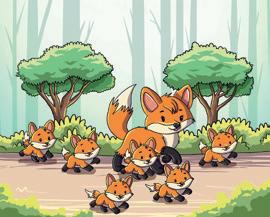

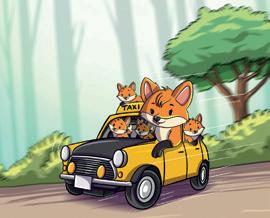

4. Interactive Read-Aloud: Read aloud the story of letters Xx from the story card with expressions and voice modulation. Ask children to repeat the words with /ks/ sound from the story. Then, slowly read the sentences from the story one by one and ask children to repeat them after you. Discuss the story by asking questions like: How many cubs are there? / What did the fox cubs get on their birthday? / How did they go out?

Find and circle the words with /ks/ sound in the story card of letters Xx.
LO: Children will observe and identify the front and back of objects and pictures through guided exploration.
Resources: Numeracy Skillbook, page 62; a soft toy; a book; a pencil box; a phone etc.
1. Recap: Turn towards the children and say: This is my front side. Then, turn around and say: back side. Reinforce the concept back and front by showing the front and back of your palm.
2. Identifying Front and Back: Call children one by one and give them a familiar object. Guide them to show the front and the back of the object.
3. Front and Back: Ask children to open page 62 of the Skillbook. Guide children to identify the front side and back side from the pictures. Read aloud the sentences on the page. Demonstrate and show as well.












LO: Children will make shadows using their fingers and observe how light creates them.
Resources: STEM Exploration, pages 24–26; a torch
1. Light and Shadows: Refer to page 24 of the STEM Exploration book. Demonstrate the activity first and then ask them to follow along with you. Read the instructions one by one. Assist those who need help. Then, guide children to solve the questions one by one from pages 25 and 26. If possible, take children outside to observe their shadows in the sunlight.





Circle Time Story Weaving
General Awareness Vegetables
General Awareness, page 77
Foundational Literacy Do and Learn Literacy Skillbook, page 66
Foundational Numeracy Do and Learn Numeracy Skillbook, page 63
DIY Fun with Vegetables
LO: Children will develop their listening, speaking and cognitive skills through collaborative storytelling.
1. Warm-Up: Say: Today we will tell a story together! I will start the story, and each one of you will add one line. You can use your imagination— anything you like! Give a reminder: Let’s listen carefully to what our friends say before us.
2. Story Weaving: Start with a simple sentence that creates a visual image and space for additions. For example: Once there was a big red balloon flying in the sky… Pause, look around, and ask one child: What happened next? Help them say one short sentence, e.g.: It flew over a tall building. If needed, gently guide or offer a prompt like: Did the balloon go up or down? / Did it meet the wind? Continue around the circle, with each child adding a line. Keep the story light and fun.
3. Concluding the Story: After all children have added their part, wrap up the story with a cheerful ending that includes or reflects what most children said. Example: And then the balloon slowly came down into the classroom, and everyone cheered and said—Welcome back, balloon!
Discuss with children and come up with a title for the story.

LO: Children will recognise and name some common vegetables. Resources: General Awareness, page 77; some real vegetables or pictures of vegetables—potato, carrot, capsicum, tomato, etc.

1. Healthy Vegetables: Say: Today, we will learn about vegetables! Vegetables grow on plants and are good for our body. Pick up one vegetable at a time. Let children look closely. Examples: This is a carrot. What colour is it? Yes, orange! / This is a tomato. It’s red and round. Let children repeat the names after you. Speak clearly and slowly.
2. Healthy Eating: Say: Vegetables help us grow strong and healthy. We eat them in many ways—raw, cooked, or in soups. Ask:
• Do you eat vegetables at home?
• Which vegetable do you like the most?
Practise
3. Vegetables: Ask children to open page 77 of the General Awareness book. Show the pictures one by one and say aloud the names of the vegetables. Let children repeat after you.
























LO: Children will identify the symbols U, V, W , X and identify words with sound /u/, /v/, /w/ and /ks/.
Resources: Literacy Skillbook, page 66; letters flashcards of U, V, W and X (from Skillbook); sticker sheet (from Skillbook)
Introduction
1. Matching Uppercase and Lowercase Letters: Write the uppercase letters of U, V, W and X on the board one by one and ask children to hold up the flashcards showing the corresponding lowercase letters. Monitor and guide children as required.
2. Identifying Letter Sounds: Say aloud words with /u/, /v/, /w/ and /ks/ sounds in a random order. Ask children to listen to the words carefully, identify the sounds and hold up the correct letter flashcards. Guide them, as required.
Practise
3. Do and Learn: Ask children to open page 66 of the Skillbook. First, guide them to identify the pictures and paste the correct letter beside each picture, from the sticker sheet. Then, ask them to match the uppercase letters with their corresponding lowercase letters.
LO: Children will identify the front and back of different objects.







Resources: Numeracy Skillbook, page 63; some objects like a book, a phone, a bag, a pencil box, etc.
1. Identifying Front and Back: Show the front or back of familiar objects one at a time (e.g. a book, a shirt, a bag). Say: Look carefully! Is this the front or the back?
Ask children to respond by showing:
• Front of their palm if they see the front of the object.
• Back of their palm if they see the back of the object.
Give praise for correct responses and gently guide when needed. Repeat with 4–5 different objects to reinforce the concept.
2. Do and Learn: Ask children to open page 63 of the Skillbook. Guide them to identify the things shown on the page and circle the ones showing the back.














LO: Children will identify the colours, shapes and names of the vegetables through a fun, active sorting and identification game.
Resources: Vegetables of different colours; 2 empty baskets
1. Vegetable Hunt: Say: Let’s play a vegetable game! I will name a vegetable, and you find it and bring it to me. Call children one at a time or in small groups. Ask:
• Can you find the red tomato?
• Can you get the long green cucumber?
• Who can pick the orange carrot?
Let each child pick and bring the right vegetable. Clap and cheer when they get it right.
2. Sorting Vegetables: After identifying, say: Let’s sort the vegetables into two baskets: green ones here, other colours there.
Children place vegetables by colour (or you can do by shape/size: round, long, leafy).
Draw and colour any two vegetables that you see at home.

Circle Time
Memory Chain
General Awareness Raw and Cooked Vegetables
General Awareness, page 78
Foundational Literacy Do and Learn Literacy Skillbook, page 67
Foundational Numeracy Front and Back Numeracy Workbook, page 40
DIY Mandala Rangoli
Art and Craft, pages 24–25
LO: Children will build memory, sequencing, and language skills in a fun and engaging way.
1. Warm-Up: Say: Let us build a memory chain! We will take turns saying what we like. Each child will repeat what others said before them, and then add their own.
2. Memory Chain Game: Begin with a simple sentence: I like apples. Turn to the next child and say: Now it’s your turn! Can you say what I said, and add one more thing you like? Example: Child 1: I like apples and I like dolls. Child 2: I like apples, I like dolls, and I like cars. ...and so on.
3. Guiding Children: Speak slowly and clearly to help children follow along. Gently remind or whisper the words if a child forgets. Accept small changes or skipped items with encouragement, especially for younger children. Limit the group size or stop the chain after 5–6 children for very young groups to keep it fun and manageable.

LO: Children will identify and differentiate between raw and cooked vegetables. Resources: General Awareness, page 78; vegetables like potato, brinjal, cucumber, tomato, etc.; some boiled vegetables like potatoes, peas, and carrots
1. Show and tell: Place a few raw vegetables (e.g. carrot, cucumber, tomato) and a few cooked vegetables (e.g. boiled potato, boiled peas) on two separate plates. Say: Let us look at vegetables! Some we can eat just like this—they are called raw vegetables. Others are cooked before we eat them—they are called cooked vegetables.
Show each plate and say the names of the vegetables. Let children observe the look and feel (pass them around if safe and hygienic). Ask: How do the raw vegetables and the cooked vegetables feel? Listen to all responses. Say: Raw vegetables are a bit hard and crunchy. Cooked vegetables are soft.
2. Raw and Cooked Vegetables: Ask children to open page 78 of the General Awareness book. Help them identify the vegetables that need to be cooked and the ones that can be eaten raw as salad. Then, guide them to circle the vegetables that can be eaten as salad.







LO: Children will identify the first letters of the words and make fingerprints. Resources: Literacy Skillbook, page 67; paint








With the help of an adult, take a few vegetables and identify the ones that need to be cooked and the ones that can be had raw as salad.
1. Identifying the Beginning Sound: Say some words aloud and guide the children to identify their beginning or ending sounds (for letter x) , as well as the letters they start or end with. For example, say: /w/ /w/ wall – help children identify the beginning sound /w/ and the first letter ‘W’.
2. Identifying First Letter: Call children one by one. Say aloud a word and write the word on the board, for example, say: van and write __ a n. Guide children to identify the beginning sound /v/ and the first letter V. Ensure everyone gets a turn and repeat with different words each time.

3. Do and Learn: Ask children to open page 67 of the Skillbook. Guide them to identify the pictures and fill in the blanks with the missing letters. Then, demonstrate and guide them to dip their fingers in the paint to make the pictures given below.












LO: Children will identify the front and back of animals and match them.
Resources: Numeracy Workbook, page 40; some toys (dolls, soft toys, animal toys)
1. Recap: Call children one by one. Ask them to pick a toy and guide them to identify the front and back of each toy. Ensure everyone gets a turn.
2. Front and Back Movement: When you say Front, ask children to face towards you. When you say Back, ask children to turn around and show their back. Demonstrate and guide them to do the activity.
3. Front and Back: Ask children to open page 40 of the Workbook. Guide them to identify the animals and match the front and back of each animal.
LO: Children will colour a rangoli pattern using crayons.
Resources: Art and Craft, pages 24–25; crayons
1. Warm-Up: Ask: Do you know when we make rangoli? Listen to all responses. Then, say: We make rangoli during festivals like Diwali. We use colours or flower petals to make rangoli.
2. Mandala Rangoli: Ask children to open pages 24–25 of the Art and Craft book. Guide them to identify the colours used in the rangoli and complete the rangoli by colouring it, using crayons.












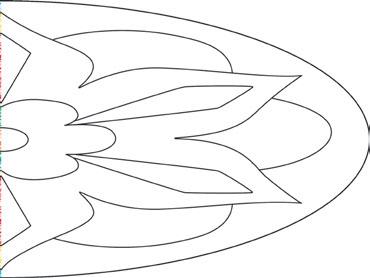



You can make a simple rangoli, using flowers/chalk in the corner of the classroom to show the children.







Domain General Awareness
Learning Outcome Children will identify vegetables and differentiate between vegetables that are eaten raw or cooked.
Resources Some vegetables like—potato, cucumber, carrot, cauliflower, capsicum etc.; two baskets
Suggested Method Call children one by one. Ask them to name any two vegetables. Then, guide them to sort vegetables that can be eaten raw and the ones that need to be cooked and keep them in two different baskets. Clap for each child and ensure everyone gets a turn.
Support for Struggling Learners
Pair the struggling learner with a confident learner. Ask them to refer to page 77 of the General Awareness book. The buddy points to each vegetable and says their names aloud. Ask the learners to repeat after the buddy.
Domain Foundational Literacy
Learning Outcome Children will connect the sounds and symbols of letters Xx.
Resources Literacy Skillbook, page 64; letters Xx story cards; chalk
Suggested Method Write letters Xx on the board, call children one by one to trace the letters with chalk and say aloud two words ending with /ks/ sound. Finally, use the story card to read the story aloud while emphasising the words with the /ks/ sound. Ask the children to repeat these words after you.
Support for Struggling Learners
Gather the learners in a circle. Show them pictures with /ks/ sound from page 64 of the Skillbook. For example, say: /ks/ /ks/ box and ask the children to repeat after you. Repeat the same for pictures and words in the story card. Then write letters X and x on the board, call the children one by one and ask them to trace the letters with chalk.
Domain Foundational Numeracy
Learning Outcome Children will identify the concept of front and back.

Resources Some common objects like books, bags, soft toys, etc.
Suggested Method Call children one by one and give them a soft toy. When you say Front, ask children to show the front side of the soft toy and when you say Back, ask children to show the back side. Clap for each child and ensure everyone gets a turn.
Support for Struggling Learners
Gather the learners together. When you say Front, ask them to turn towards you and when you say Back, ask them to turn around. Repeat 4–5 times for reinforcement. Then, take some common objects like books, bags, soft toys, etc. Help children identify the front and the back of each object.




































Domain
Circle Time
Topic of the Day
Pretend Play – Buying Fruits and Vegetables
General Awareness Fruits and Vegetables
Book & Page
General Awareness, page 79
Foundational Literacy Find Out Literacy Workbook, page 43
Foundational Numeracy Left and Right
DIY Rhyme: Early in the Morning Rhymes and Stories, page 41
LO: Children will pretend to buy fruits and vegetables from the market.
Resources: Some real or toy fruits and vegetables; some cloth bags; trays
1. Introduction: Say: Have you ever gone to the market with your family? What do you see there? Encourage each child to participate and share their answers. Show the items and say: These are fruits, vegetables, and other things we find at the market. Set up one table as a market with trays of fruits and vegetables.














2. Pretend Play: Call two children at a time and ask one child to be a customer and the other to be a shopkeeper. Guide the customer to name a fruit and a vegetable that they want to buy. For example: I need one potato and one apple. Let the shopkeeper identify the items and put them in the bag of the customer. Ensure everyone gets a turn.

LO: Children will identify, name and sort fruits and vegetables through observation and guided activity.
Resources: General Awareness, page 79; some fruits and vegetables; 3 baskets
Introduction
1. Warm-Up: Show the fruits and then the vegetables to the children and say their names one by one. Ask children to repeat the names after you.
2. Sorting Fruits and Vegetables: Mix the fruits and vegetables in one basket. Then show two baskets and say: We will keep the fruits in this basket and the vegetables in the other basket. Call children one by one and guide them to sort the fruits and vegetables in two different labelled baskets.
3. Fruits and Vegetables: Ask children to open page 79 of the General Awareness book. Guide them to draw lines to match the fruits and vegetables in the correct basket. Assist those who need help.




















LO: Children will identify the missing letters to complete simple words by listening to sounds and observing picture cues.
Resources: Literacy Workbook, page 43
1. Guess the Missing Letters: Call children one by one, say a word aloud and write the word on the board with the first letter or last letter (for x) missing. Guide children to identify the correct letter to fill in the blank. For example, say: /u/ /u/ umpire and write __mpire on the board. For letter X, say aloud a word and ask children to guess the last letter. Example, say: /ks/ /ks/ box and write bo__ on the board.
2. Find Out: Ask children to open page 43 of the Workbook. Guide them to identify the pictures, say its name aloud emphasising the beginning sound and fill in the missing letters.




LO: Children will recognise the concept of left and right using their body, familiar objects, and everyday examples.
Resources: Some toys – a ball, a soft toy etc.; a ribbon or sticker
1. Left and Right: Start by saying: Let us learn something fun—our left and right sides! Show your left hand and say: This is my left hand. Show your right hand and say: This is my right hand. Use a ribbon or sticker on the right wrist as a marker. Then recite the rhyme Left and Right with actions and expressions and ask children to recite along.
Touch your left foot! Raise your right hand! Clap with both hands!

2. Left and Right Game: Place one object on each side:
• A toy on the left
• A ball on the right
Call children one by one and give instructions like: Point to the object on your left. / Pick up the ball on your right. Guide and monitor the children as required. Ensure everyone gets a turn.
3. Connecting with Real Life: Say: We use left and right every day! Let’s think of some examples. Give simple examples:
• We wear our school bags on our right shoulder or left shoulder.
• The steering wheel in a car is on the right side.
• In the classroom, your cubby is on the left/right side of the shelf.
Ask questions to involve children:
• Which hand do you eat with?
• Which side is the window?
• Which side is your water bottle on?
Encourage pointing and responding.
Sit in a room with an adult. Look around and name things on your left and right sides.
LO: Children will recite the poem Early in the Morning with voice modulation and expressions. Resources: Rhymes and Stories, page 41
1. Warm-Up Discussion: Ask children to open page 41 of the Rhymes and Stories book. Ask them to look at the pictures and share what they see. Listen to all responses and say: We see a train, and some children sitting inside the train. Smoke is coming out of the engine. Then, ask: Did anyone ever sit on a train? Let children share their responses.
2. Early in the Morning: Recite the poem Early in the Morning with voice modulation and expressions and ask children to recite along. Repeat 3–4 times to help children remember the poem.
Pro Tip


If there is space, call 3–4 children to form a train by holding each other’s shoulders. Let them walk around saying Choo Choo!
Domain
Topic of the Day
Circle Time Action Sequence
General Awareness What Comes Next?
Book & Page
General Awareness, page 80
Foundational Literacy Do and Learn Literacy Workbook, page 44
Foundational Numeracy Left and Right Numeracy Skillbook, page 64
DIY Rhyme: Early in the Morning Rhymes and Stories, page 41
LO: Children will perform actions in a sequence and try to remember them.
1. Warm-Up: Say: Today, we are going to play a fun game where we perform actions in a special order. You have to listen carefully and try to remember! Explain with excitement: First, I will do the actions, and you will watch. Then you will try to copy the same actions in the same order.
2. Action Sequence: Start with 2 or 3 simple movements like:
• Clap your hands
• Jump once
• Touch your head
Say each action clearly and do it slowly: Clap – Jump – Head! Repeat the sequence twice. Then say: Now it’s your turn! Let children try it together once or twice. Repeat with different actions like: Clap – Stomp – Wave / Jump – Turn – Clap – Head.
You can also ask children to create their own action patterns and ask others to follow.

LO: Children will identify and complete vegetable patterns by observing sequences and predict what comes next.
Resources: General Awareness, page 80; 4 different vegetables (2 of each)
Introduction
1. Understanding Patterns: Make a pattern using two vegetables (say, tomato and potato). Make a repeating pattern with one item missing (potato – tomato – potato). Ask children to observe the pattern and guess the one that will come next. Show 3–4 patterns using different vegetables.

2. What Comes Next: Ask children to open page 80 of the General Awareness book. Guide them to identify the vegetables in each row and tick the vegetable that will come next to complete the pattern.










LO: Children will look at pictures of objects and identify their first letters. Resources: Literacy Workbook, page 44; letter flashcards (from Skillbook)
1. Identifying First Letter: Give 2–3 letter flashcards randomly to each child. Say a word aloud, clearly stressing the beginning sound. For example: /u/ /u/ umbrella. Ask: What sound does it begin with? Help children identify the first letter. The child who has the matching letter flashcard should hold it up. Repeat with other words and sounds.
2. Do and Learn: Ask children to open page 44 of the Workbook. First, guide them to circle the picture that begins with the given letters. Then, guide them to look at the pictures and colour the box with the correct letter.
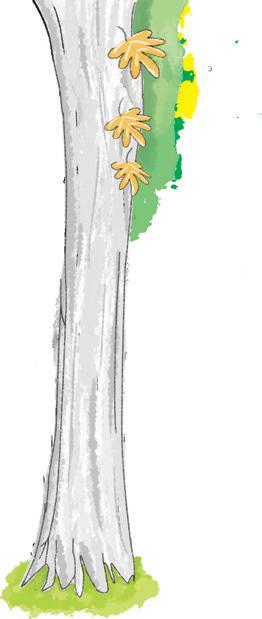


























LO: Children will identify the directions left and right through hands–on activities and by looking at arrows. Resources: Numeracy Skillbook, page 64; 2 boxes; a ball
1. Recap: Ask children to raise their left hands and then their right hands. Repeat 3–4 times. Then, recite the Left and Right rhyme from the previous sessions.
2. Choose the Correct Box: Place both the boxes in the classroom, one on the left side and the other on the right. Call children one by one. First, ask them to place the ball in the left box and then in the right box. Ensure everyone gets a turn and guide children as required.
3. Left and Right: Draw a left arrow and a right arrow on the board and help children identify them (use 2 different coloured chalks). Then, ask children to open page 64 of the Skillbook. First, help them identify the car that is moving left and the one moving right. Then, guide them to circle the right arrows in green, and the left arrows in red.




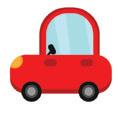





LO: Children will recite the rhyme Early in the Morning and create a train through a guided craft activity.
Resources: Rhymes and Stories; page 41; white rectangular paper cut-outs (2 per child); crayons; cotton; drawing sheet; glue
1. Rhyme Time: Recite the rhyme Early in the Morning with actions and expressions and ask children to recite along. Repeat 3–4 times.
2. Making a Train: Help children to paste the rectangles on the drawing sheet to make a train. Guide them to colour the rectangles, draw windows and the wheels. Finally, help them paste cotton to show smoke coming from the engine.



Circle Time My Favourite Fruit and Vegetable
General Awareness
Drawing Favourite Fruits and Vegetables
Foundational Literacy Letter Yy Literacy Skillbook, pages 68–69; Literacy Workbook, page 45
Foundational Numeracy Left and Right Numeracy Workbook, page 41
DIY Story: The Clever Monkey and the Crocodile Rhymes and Stories, pages 42-46
LO: Children will talk and share about their favourite fruits and vegetables.
1. Warm-Up: Start with an engaging question: What is your favourite fruit or vegetable? Say: Fruits and vegetables help us grow strong and healthy. Today we will talk about which ones we like the most! Give a simple example: My favourite fruit is mango because it’s sweet and juicy. My favourite vegetable is carrot because it’s crunchy.
2. Sharing Time: Invite each child to share their favourite fruits and vegetables. Say: Can you tell us your favourite fruit and vegetable? Use prompts to help children who are shy:
• Is it red, yellow or green?
• Do you like to eat it raw or cooked?
• Is it crunchy or soft?
Let children point if they are unsure of the name.
You can keep some real or toy fruits and vegetables and let children choose their favourite ones from them and talk about it.

LO: Children will draw and colour their favourite fruit and vegetable.
Resources: Drawing sheets; crayons
1. Warm-Up: Say: During circle time, we talked about our favourite fruits and vegetables. Now, you will draw the ones you love the most! Briefly recall a few names children shared earlier. Draw and show some examples on the board.
2. Drawing Time: Say: Draw and colour your favourite fruit and vegetable. Distribute drawing sheets and crayons. Walk around, support children with ideas or identifying colours if they ask. Encourage effort: Wow, that mango looks yummy! / What a bright red tomato!
3. Displaying the Work: After drawing, invite children one by one to show their drawing and say: This is my favourite fruit/vegetable—I love it because…







LO: Children will identify the symbol and sound of the letters Yy and write the letters.
Resources: Literacy Skillbook, pages 68–69; Literacy Workbook, page 45
1. Singing to Letters Yy: Introduce the letters Yy with a rhyme. Repeat it at least 2–3 times, encouraging the children to join in.
Letter Yy Rhyme /y/ /y/ yellow yarn, /y/ /y/ yak on a farm. /y/ /y/ yawn when it’s night, /y/ /y/ yogurt is a delight!
2. Listening to /y/ Sound: Guide the children to page 68 of the Skillbook. Point to each picture and say the word, emphasising the /y/ sound. For example: /y/ /y/ yak or /y/ /y/ yellow.
3. Symbol Recognition of Letters Yy: Write capital Y and small y on the board. Then, ask everyone to finger trace the letters in the air using their index fingers. Call children one by one to trace the letters on the board.
4. Writing Practice of Letters Yy: Guide the children to page 68 of the Skillbook. Ask them to trace the letters Yy carefully. Support those who need help.
5. Activity on Letters Yy: Ask children to open page 69 of the Skillbook. Guide them to colour the boxes showing pictures that begin with the /y/ sound.

















Refer to page 45 of the Workbook, trace and write the letters Y and y.

LO: Children will recall the concept of left and right through a fun activity and colouring.
Resources: Numeracy Workbook, page 41; blue and red crayons
1. Fun with Movement: Recall the concept of left and right through fun movement games. Give them instructions like:
• Raise and wave your right hand
• Raise and wave your left hand
• Stomp your right leg
• Stomp your left leg
2. Left and Right: Ask children to open page 41 of the Workbook. First, guide them to place their left and right hands on the impression. Then, ask them to draw fingernails on the left hand with a blue crayon and on the right with a red crayon.



LO: Children will discuss the story The Clever Monkey and the Crocodile by observing and talking about the pictures.
Resources: Rhymes and Stories, pages 42–46
1. Warm-Up: Ask: Do you know where a monkey and a crocodile live? Listen to all responses, then say: A monkey lives in a tree and crocodile lives in water. Then, play a quick action game. When you say Monkey, let children jump and when you say Crocodile, let them pretend to swim. Mix up the commands, and repeat several times to make it fun and engaging.



2. Picture Talk: Refer to pages 42–46 and ask children to look at the pictures. Ask them questions like:
• What animals do you see in the picture?
• What is the monkey doing?
• What is the crocodile doing?
• What else do you see in the picture?
Domain
Topic of the Day
Circle Time Story Time
General Awareness Vegetable Printing
Book & Page
Foundational Literacy Letter Yy Literacy Skillbook, 68–69; Letter Y Story Card.
Foundational Numeracy Position Game: Where Am I?
DIY Story: The Clever Monkey and the Crocodile Rhymes and Stories, pages 42–46
LO: Children will listen to a story understand where fruits and vegetables come from.
1. Story Time: Greet the children warmly and say: Let me tell you a story about where our fruits and vegetables come from! Narrate the story Tara and the Magic Farm with expressions and voice modulations. Narrate the story 2–3 times to help the children remember.
2. Discussing the Story: Ask simple questions:
• Who grows fruits and vegetables? (Farmer)
• Where do fruits grow? (On trees or plants)
• Where do plants come from? (Seeds) Help children answer the questions.
Tara and the Magic Farm
One day, a curious girl named Tara asked, “Where do apples and carrots come from?” Her grandma smiled and said, “Let’s visit the farm!” At the farm, Tara saw apples and mangoes on trees. She also saw tomatoes and carrots growing from the ground. A friendly farmer said, “I plant seeds, water them, and take care of them. Some grow into trees, and some into plants.” Tara smiled and said, “Thank you, trees! Thank you, farmer!”
If possible, plant a seed in a pot and show it to children. Let children water it daily and observe its growth.


LO: Children will make an artwork using vegetable prints.
Resources: Pre-cut vegetables (ladyfinger, potato, carrot, capsicum, etc.); paint; drawing sheet

1. Warm-Up: Say: Today, we will make beautiful pictures using vegetable prints. Show the vegetables and their cut surfaces. Ask: What do you think will happen when we press this on paper? Show a simple demo by dipping a piece in paint and pressing it gently on paper.
2. Vegetable Printing: Let each child choose a vegetable and a paint colour. Guide them to dip and press on paper to make prints. Encourage mixing colours and patterns, you can say: Try using red paint with the carrot, or green with the ladyfinger. Remind them not to rub or slide the vegetable—just press and lift. Support children who need help with dipping or placement.







LO: Children will identify the symbol and sound of the letters Yy and write them.
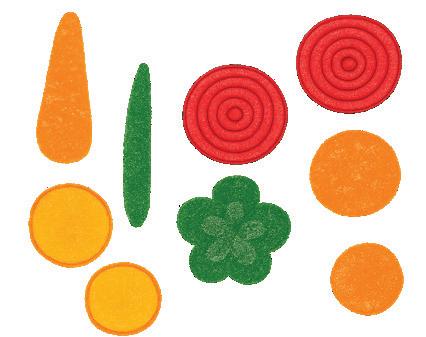
Resources: Literacy Skillbook, pages 68–69; Literacy Workbook, page 45, Letter Y Story Card
1. Recalling Sound of Letters Yy: Reinforce the sound of letters Yy by showing pictures from page 68 of the Skillbook, emphasising the /y/ sounds. For example, say: /y/ /y/ yoga. Then, write letters Y and y on the board and invite children to trace them.
2. Letters Yy: Read aloud the sentences given on page 69 of the Skillbook emphasising the words starting with /y/ sound. Ask the children to repeat the words after you and circle the words starting with letters Yy.

















3. Picture Talk: Show the pictures from the story card and discuss them one by one. Ask:
Picture 1: What is the boy holding?
Picture 2: What animal do you see?
Picture 3: What do you see in the river?
Picture 4: What is the boy doing?
4. Interactive Read–Aloud: Read aloud the story of letters Yy from the story card with expressions and voice modulation. Ask children to repeat the words beginning with /y/ sound from the story. Then, read each sentence slowly and ask children to repeat. Discuss the story by asking questions like: Who did the boy meet in the meadow? / With what is the boy playing? / Who is yawning? / What is sailing down the river?




Find and circle the words with /y/ sound in the story card of letters Yy.
LO: Children will identify and differentiate between position words.
Resources: A table, chair, and a box or basket; a soft toy
1. Recap: Say: Today we will play a fun game using our bodies to show where things are! Use a toy or small object (like a teddy) to show different positions. For example: In the box, out of the box, on the chair, left side of the toy, right side of the toy and so on. Say each word clearly and show each position. Let children repeat the word and copy your movement.
2. Game Time: Give quick instructions and let children act them out.
Example:
• Sit on the chair!
• Stand in front of the chair!
• Put your hand up… now down!
Monitor and guide as required.
• Go under the table!
• Touch your left hand!
LO: Children will listen to the story The Clever Monkey and the Crocodile and make an origami monkey. Resources: Rhymes and Stories, pages 42–46; a square paper (per child); black markers
1. Interactive Read-Aloud: Read aloud the story The Clever Monkey and the Crocodile with expressions and voice modulations. Pause to show pictures and ask questions like:
• What is the name of the monkey and the crocodile?
• What was the monkey picking?
• Why did the monkey throw the fruit from the tree?
• What did Miko do when Kavi tried to catch him?

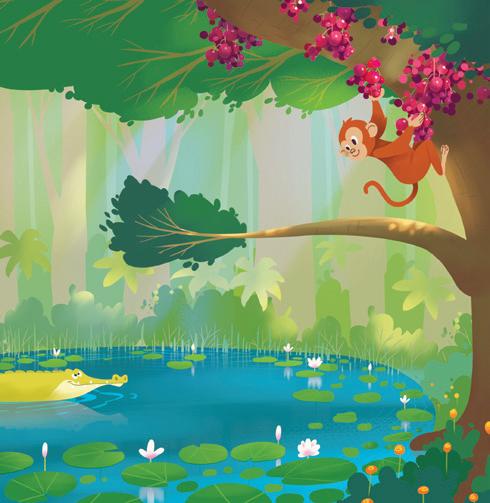

2. Origami Monkey: Give a square piece of paper to each child. Demonstrate and guide them to make a monkey’s face. Follow the steps shown in the picture. At the end, help children draw the monkey’s eyes and nose using a marker.










Domain General Awareness
Learning Outcome
Children will identify, name, and sort fruits and vegetables.
Resources Some common vegetables and fruits; 3 baskets
Suggested Method
Support for Struggling Learners
Mix all the fruits and vegetables, then keep them in a basket. Call children one by one. Ask them to sort the fruits and vegetables into separate baskets. Ask them to identify and name the fruits and vegetables while sorting them. Clap for each child. Ensure everyone gets a turn.
Gather the learners together. Take some familiar fruits and vegetables. First, name all the vegetables and then the fruits and ask children to repeat after you. Then, sort the fruits and vegetables and show the children.
Domain Foundational Literacy
Learning Outcome Children will connect to the sounds and symbols of the letters Yy.
Resources Literacy Skillbook, page 68; letters Yy story cards
Suggested Method
Support for Struggling Learners
Write letters Yy on the board, call children one by one to trace the letters with chalk and say aloud two words starting with /y/ sound. Finally, use the story card to read the story aloud while emphasising the words with the /y/ sound. Ask the children to repeat these words after you.
Gather the learners in a circle. Show them pictures with /y/ sound from page 68 of Skillbook. For example, say: /y/ /y/ yellow and ask the children to repeat after you. Repeat the same for pictures and words in the story card. Then write letters Y and y on the board, call the children one by one and ask them to trace the letters with chalk.
Domain Foundational Numeracy
Learning Outcome Children will identify the concept of left and right.
Resources A soft toy; 2 boxes
Suggested Method
Support for Struggling Learners
Place a box on the right side of a table and the other on the left side. Call children one by one. First, ask them to put the soft toy in the right box and then in the left box. Clap for each child and give them a smiley. Ensure everyone gets a turn.
Gather the learners together. Explain the concept of left and right using body movements. Demonstrate and guide them to do simple actions like: waving the right/left hand; touching the right/left eye or ear; stomping the right/left foot. Reinforce the words ‘left’ and ‘right’ as you do the actions and ask children to repeat after you.



























Circle Time
General Awareness
Let’s Exercise
Healthy Habits
Foundational Literacy Letter Zz
Foundational Numeracy What Comes After
DIY What to Do First?
LO: Children will perform simple stretching and breathing exercises.
General Awareness, page 81
Literacy Skillbook, pages 70–71; Literacy Workbook, page 46
STEM Exploration, pages 27–29
1. Warm-Up: Begin by saying: We will do simple stretching exercises today. Before that let us do some warm up. Do some simple warm up exercises like: nodding the head up down, from side to side, rolling the shoulders and wiggling the fingers.
2. Exercise Time: Demonstrate and guide children to do the following exercises:
• Stretch Up High – Ask children to reach tall as if touching the sky. Hold the stretch for 5 seconds.
• Bend Down Low – Bend to touch the toes and count to 5.
• Side Stretch – Reach one hand over the head and lean to the opposite side. Repeat on both sides. Repeat 2 times for a fun warm-up.
3. Cool Down: Ask children to sit down in their places and close their eyes. Ask them to take in a deep breath (like smelling a flower) and then exhale (like blowing a candle). Repeat 5–6 times.

LO: Children will identify and discuss healthy habits. Resources: General Awareness, page 81
1. Discussion Time: Say: Let us talk about how we can take care of our bodies and feel good every day! Ask simple questions to begin the discussion:
• What do you do after you wake up?
• What foods help us grow strong?
Encourage children to share what they do at home.
• Why do we brush our teeth?

2. Healthy Habits: Ask children to open page 81 of the General Awareness book. Discuss the pictures one by one and help them identify which habits are healthy and which are not. For example, say: The boy is swimming. Exercising and keeping our body fit is a healthy habit. / The boy is putting a pencil in his ear; he can hurt himself. It is not a healthy habit
Only discuss the pictures given on page 81 in this session. DO NOT solve the page.
3. Interactive Game Time: Play a quick “Yes or No” game. Say: If it is a healthy habit, clap your hands. If it is not, stay still. Examples:
• Eating vegetables and fruits (Yes – clap)
• Not brushing teeth (No – stay still)
• Playing outside (Yes – clap)
• Skipping sleep (No – stay still)
Ask children to share the healthy habits that they follow.
















LO: Children will identify the symbol and sound of the letters Zz and practise writing it.
Resources: Literacy Skillbook, pages 70–71; Literacy Workbook, page 46
1. Singing to Letters Zz: Introduce the letters Zz with a rhyme. Repeat it at least 2–3 times, encouraging the children to join in.
2. Letters Zz: Guide the children to page 70 of the Skillbook. Point to each picture and say the word, emphasising the /z/ sound. For example: /z/ /z/ zebra.
3. Symbol of Letters Zz: Write capital Z and small z on the board. Then, ask children to trace the letters in the air using their index fingers. Call children one by one to trace the letters on the board.
4. Writing Practice of Letters Zz: Guide the children to page 70 of the Skillbook. Ask them to trace the letters Zz. Support those who need help.



Letter Zz
/z/ /z/ Z is here!
/z/ /z/ Zebra runs near.
/z/ /z/ Zoom goes the car, /z/ /z/ Zipper on my jar!
/z/ /z/ Let’s zig and zag, With a /z/ /z/ zip in our bag.


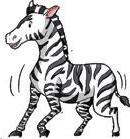










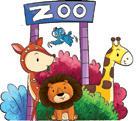

5. Activity on Letters Zz: Ask children to open page 71 of the Skillbook. Guide them to circle the pictures that begin with /z/ sound.
Refer to page 46 of the Workbook. Ask children to complete tracing letters Zz.
LO: Children will identify the concept of “after” using real-life examples. Resources: Some common classroom objects like—chalk, duster, pencils, crayons, etc.
1. Examples from Real Life: Say: Let us think about what we do every day. What comes after we wake up?
Prompt with real examples:
• Wake up → brush teeth
• Eat lunch → clean up
• Brush teeth → eat breakfast
• Come to school → put bag down Ask: What do we do after finishing our lunch? Encourage children to answer and build small sequences with your help. Explain that “after” means what comes or happens next.
2. Object Based Examples: Use real classroom items placed in a row (e.g. chalk, crayon, pencil, duster, etc.). Explain with an example: The crayon is placed after the chalk. Then, point to one object and ask: What is kept after this? Let children take turns identifying or picking the next item in the row. Ensure everyone gets a turn to share.
3. Who is After Me: Call 3–4 children and ask them to stand in a line. Then, go to each child one by one and ask: Who is standing after you? Guide them to identify the concept of after and say their friend’s name. Ensure everyone gets a turn.
LO: Children will learn to arrange events in the correct order. Resources: STEM Exploration, pages 27–29
1. Warm-Up: Ask: What do we do after waking up in the morning? Encourage each child to participate and give responses. Then, give them the following situations: brushing teeth, coming to school, waking up and guide them to arrange them in the correct order (For example: waking up, brushing teeth, coming to school).
2. What to Do First: Refer to pages 27 and 28 of the STEM Exploration book. Help children arrange the steps in the correct order on the ambulance and truck illustrations. Assist those who need help.






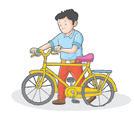






Circle Time
General Awareness
Mindfulness
Healthy Habits
General Awareness, page 81
Foundational Literacy Letter Zz Literacy Skillbook, pages 70–71; Letter Z Story Card
Foundational Numeracy What Comes After Numeracy Skillbook, page 65
DIY What to Do First?
STEM Exploration, pages 27–29
LO: Children will practise mindfulness through simple breathing exercises and listening to a bell. Resources: A bell or chime
1. Calm Breathing: Say: Let us sit quietly and calmly for a few moments. Put your hands on your tummy and close your eyes gently. Guide children to breathe in slowly through their nose and feel their tummy rise. Breathe out slowly through the mouth. Do this together 3–5 times. Use soft counting (1 to 3 in, 1 to 3 out) if needed.
2. Mindful Listening: Say: Let us use our ears like superheroes! Listen closely. Ring a soft chime or tap a bell gently. Ask them to raise their hand when they can’t hear the sound anymore. Do this 2–3 times to help focus their attention.
3. Know Our Feelings: Say: Let us think about how we feel right now. Put your hand on your heart. Ask them about simple feelings like: Do you feel happy, sleepy, calm or excited? Use gestures if needed. Encourage children to say how they feel in one word or choose from given options.

LO: Children will identify and enact different healthy habits. Resources: General Awareness, page 81
1. Recap: Begin by asking: Can you a few healthy and unhealthy habits? Let children share their answers. Listen to all responses and correct children if required.
2. Acting Time: Call children one by one and ask them to enact and show a healthy habit. Let other children guess the habit. Give actions like:
• Holding a toothbrush and pretending to brush
• Washing hands
• Drinking water from a glass
• Playing outdoor sports or games – football, cycling, etc.
• Eating a fruit
Ensure each child gets a turn to enact a habit.
3. Healthy Habits: Ask children to open page 81 of the General Awareness book. Guide children to identify the actions shown in the picture and tick the ones that show healthy habits.
















LO: Children will practise saying aloud a few words and listen to phonic stories with words that begin with letters Zz.
Resources: Literacy Skillbook, pages 70–71; Letter Z story card
1. Recalling Sound of Letters Zz: Reinforce the sound of letters Zz by showing pictures from page 70 of the Skillbook, emphasising the /z/ sounds. For example, say: /z/ /z/ zebra. Then, write letters Z and z on the board and invite children to come and trace the letters.
2. Letters Zz: Read aloud the sentences given on page 70 of the Skillbook emphasising the words starting with /z/ sound. Ask the children to repeat the words and circle the words starting with letters Zz.
3. Picture Talk: Show the pictures from the story card and discuss them one by one. Ask:
Picture 1: What animal do you see?
Picture 2: What is inside the ziplock bag?
Picture 3: What is the zebra doing?
Picture 4: What other animals do you see?









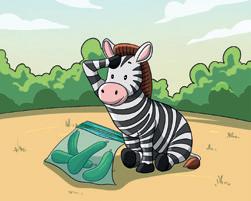











4. Interactive Read-Aloud: Read aloud the story of letters Zz from the story card with expression and voice modulation. Ask children to repeat the words with /z/ sound from the story. Read each sentence slowly and ask children to repeat. Discuss the story by asking questions like: Who found a ziplock bag in the zoo? / What was in the ziplock bag? / With whom did the zebra share the zucchini?

Find and circle the words with /z/ sound in the story card of letters Zz.

LO: Children will identify the concept of after by looking at different things and pictures.
Resources: Numeracy Skillbook, page 65; some common classroom objects
1. Recap: Place three objects in a row, (for e.g., a chalk, crayon and a pencil). Demonstrate the objects and explain that the crayon comes after the chalk and the pencil comes after the crayon. Repeat 3–4 times for reinforcement.
2. Identifying the Objects: Place any three objects in a row, (for e.g., a pencil box, a book and a water bottle). Call children one by one and ask them questions like: What comes after the pencil box? / What comes after the book? Guide children to identify and state the correct object. Ensure everyone gets a turn and change the objects each time you call a new child.
3. What Comes After: Ask children to open page 65 of the Skillbook and look at the pictures. Help children identify what comes after the ball and the kite. Then, ask them to circle the pictures that come after the object mentioned.

















Discuss school routine using ‘after’. Ask questions like: What do we do after circle time? / What do we do after eating lunch?
LO: Children will identify and arrange events in order.
Resources: STEM Exploration, pages 27–29; a deflated balloon and an inflated balloon; cards showing steps of cleaning a car (per child)
1. Sequencing the Event: Show an inflated balloon and a deflated balloon to children. Ask them to think and share the order in which the balloon was inflated. Listen to all responses and then explain: First we take a deflated balloon, blow air into it and then we get an inflated balloon to play with.
2. What to Do First?: Refer to page 28 of the STEM Exploration book. First, guide children to identify the sequence of repairing a flat tire of a bicycle. Hand each child the cards showing car-cleaning steps. Guide them to arrange the cards in order. Monitor and guide as required.









Circle Time
Debate: Indoor or Outdoor Games
General Awareness Healthy and Unhealthy Food
Foundational Literacy Do and Learn
General Awareness, page 82
Literacy Skillbook, pages 72–73
Foundational Numeracy Do and Learn Numeracy Skillbook, page 66
DIY Hot–Air Balloon
Art and Craft, page 26
LO: Children will develop their listening and speaking skills by sharing their preferences.
Resources: Any indoor game—a puzzle/blocks; a ball; a soft toy
1. Warm-Up: Make the children sit in a circle, if possible. Use two simple signs or props: one for indoor play (e.g. puzzle) and one for outdoor play (e.g. a ball). Explain: Some children like to play inside – reading books, building blocks or drawing. Others love to play outside – running, climbing or playing in the sand. We will take turns talking about which one we like more – indoor or outdoor play.
2. Speaking Time: Say: When it is your turn, you can say: ‘I like indoor play because…’ or ‘I like outdoor play because…’ Give an example: I like outdoor play because I can run fast! / I like to play indoor games because they are fun. Let children raise hands or pass a soft toy to show whose turn it is. Support shy children with prompts or offer two choices: Do you like drawing or running more?
3. Reflect Together: Say: Some of us like indoor play, and some like outdoor play – and that’s okay! We all have different favourites. Ask: Did anyone change their mind? Clap and cheer for everyone who shared.

LO: Children will identify healthy and unhealthy food items and sort them.
Resources: General Awareness, page 82; some fruits and vegetables; wrappers of chocolates, biscuits and chips; a bag
1. Discussion Time: Say: Let us talk about food today! Some foods help us grow strong, and some are just to be eaten once in a while. Ask: What did you eat today? Do you think it is good for your body? Gently introduce the idea of healthy foods (fruits, vegetables, milk, rice) and unhealthy foods (chips, sweets, soft drinks). Explain that we can eat food like chocolates, chips etc. sometimes and not everyday.

2. Mystery Bag Game: Keep the food items and wrappers in a bag. Call children one by one and let them take out any item from the bag without looking at it. Then, guide children to guess whether it is healthy or unhealthy.
3. Healthy and Unhealthy Food: Ask children to open page 82 of the General Awareness book. Guide them to identify the pictures of food items given on the page. Let them tick the healthy food items and cross out the unhealthy ones.






















LO: Children will match the capital letters with their corresponding small letters and identify the missing first letter of words.
Resources: Literacy Skillbook, pages 72–73; sticker sheet (from Skillbook)
1. Capital and Small Letters: Call children one by one. Write any one capital letter on the board. Guide children to identify the letter and write down its corresponding small letter. Repeat the activity with different letters.
2. Guess the First Letter: Say aloud a word, emphasising the beginning sound and write the word on the board with its first letter missing. For example, say: /b/ /b/ ball and write __all. Guide children to identify the missing first letter. Repeat with different words.
3. Do and Learn: Ask children to open pages 72 and 73 of the Skillbook. Guide them to identify the pictures and paste the correct letter stickers, match the capital and small letters and write the missing first letters.








Make the fingerprint art on page 73 using paint, with the help of an adult.








LO: Children will understand the concept of what comes after a given number.
Resources: Numeracy Skillbook, page 66
1. Number Train: Write numbers from 1 to 10 and recite it once along with children. Say: Today we will identify which number comes after a given number. Circle a number on the number train, say 3 and ask: Which number comes after 3? Let children observe and share their responses. Then, point and show that 4 comes after 3. Repeat with other numbers.
2. What Comes After: Call children one by one and give them a number, say 5. Guide them to identify the number that comes after the number 5. Ensure everyone gets a turn.
3. Do and Learn: Ask children to open page 66 of the Skillbook. Guide them to identify and write the numbers that come after the given numbers.
LO: Children will trace the dots to complete the design on the hot air balloon.
Resources: Art and Craft, page 26
1. Warm-Up: Ask children to open page 26 of the Art and Craft book. Show the picture of the hot air balloon and ask: Do you know what this is? Listen to all responses, and let children share freely what they think about the picture. Then, say: This is a hot air balloon! It is a big balloon that flies in the sky using hot air. People can sit in a basket under it and float gently up, up, up like a bird!










2. Hot Air Balloon: Ask children to open page 26 of the Art and Craft book. Let them trace the dots to complete the design given on the hot air balloon. If possible, get a helium gas balloon and show how it slowly goes up in the air. Explain that even a hot air balloon goes up slowly in the air and not fast like an aeroplane.

Circle Time
General Awareness
Foundational Literacy
Sequencing
Food Safety
Matching Picture and Letters
DIY Hot–Air Balloon
General Awareness, page 83
Literacy Skillbook, page 74
Foundational Numeracy What Comes After Numeracy Workbook, page 42
Art and Craft, page 26
LO: Children will understand sequencing (first, next, last) using familiar daily items.
Resources: A tiffin box; spoon; water bottle; soap; towel; a bucket of water or a pretend tap
1. Sequencing Through Daily Routine: Say: Let us think about what we do at snack time. We do things in a special order—that is called sequencing! Demonstrate: Place the three items in a row while saying:
• First, we open the lunchbox.
• Next, we eat with a spoon or hand.
• Last, we drink from the water bottle.
Repeat the order together using gestures or miming the actions. Also, demonstrate the sequence of washing hands.
2. Let Us Try: Mix the objects and ask children to come one at a time and place them in the correct order.
Prompt with questions like:
• What do you do before eating?
• What do you need after you eat?
Assist those who need help and encourage them to say it aloud.
You can also discuss other sequences in daily life like: getting ready for school; packing a bag etc.

LO: Children will understand basic food safety habits through pictures and enactment.
Resources: General Awareness, page 83; soap; some food items (fruits or vegetables); a plate with a lid
1. Understanding Food Safety: Say: Before we eat, we need to make sure the food is safe and clean. Talk about the following points and enact them.
• Washing hands before eating.
• Washing fruits and vegetables.
• Not eating from the floor. (pretend to pick up a food from floor and throw in dustbin)
• Covering food. (cover a plate with a lid)
• Drinking clean water (pretend to fill a bottle or glass with water from a filter)
• No wasting food: Say: We should not throw food. Always take a little quantity for eating. Afterwards we can take some more if we need.
Pause after each point and let children enact the same. Repeat each point 2–3 times for reinforcement.
2. Food Safety: Ask children to open page 83 of the General Awareness book. Ask children to look at the pictures and help them identify the healthy eating habits. Let them circle the ones that they follow regularly.















Go to a kitchen with an adult and observe whether food safety is followed or not.


LO: Children will match the pictures with their correct beginning letters. Resources: Literacy Skillbook, page 74; letter flashcards (from Skillbook)
1. Guess the Beginning Letters: Lay the letter flashcards in alphabetical order on a table. Call children one by one and say aloud a word emphasising the beginning sound, for example: /p/ /p/ potato. Guide children to identify the first letter from the flashcards. Ensure everyone gets a turn and give different words to each child.
2. Matching Pictures and Letters: Ask children to open page 74 of the Skillbook. Guide them to identify the pictures and match them with the correct beginning letters.














LO: Children will identify what comes after a given object or number. Resources: Numeracy Workbook, page 42; some common classroom objects
1. Looking at Objects: Keep 4–5 objects neatly in a row. For example: chalk –pencil – crayon – duster – book. Call children one by one and ask questions like: What comes after the duster? Let children observe and guide them to share their answers. Ensure everyone gets a turn.
2. Looking at Numbers: Write 1 to 10 on the board. Then call out a number (e.g. 6) and ask: What comes after 6? Let children share their answers and correct them, if required. Ensure everyone gets a turn.
3. What Comes After: Ask children to open page 42 of the Workbook. Guide them to look at the pictures and draw things that come after. Then, ask them to write the numbers that come after.
LO: Children will colour the picture of a hot air balloon. Resources: Art and Craft, page 26; crayons


1. Movement Game: Tell the children: Let us be hot air balloons! Give them cues like:
• Crouch down (say: We are getting ready.)
• Slowly rise up (say: Up, up, up we go!)
• Walk on toes with arms wide (pretend to float) You can repeat this a few times for fun and to build understanding of “up” and “down”
2. A Hot-air Balloon: Ask children to open page 26 of the Art and Craft book. Guide them to identify the colours and colour the hot air balloon using crayons.












Domain
General Awareness
Learning Outcome Children will identify and talk about healthy habits.
Resources General Awareness, page 81; a soft toy
Suggested Method Pass a soft toy around. Ask the child holding the soft toy to share any one healthy habit. You may provide them situations given below and ask them to say whether it's a good habit or a bad habit:
• Eating fruits
• Putting a pencil in your ear
• Swimming
• Eating chocolate
• Drinking cold drinks
• Sleeping early.
Clap for each child and give them a smiley. Ensure everyone gets a turn.
Support for Struggling Learners
Domain
Gather the learners together. Refer to page 81 of the General Awareness book. Show the pictures one by one and help them identify the healthy habits.
Foundational Literacy
Learning Outcome Children will connect to the sounds and symbols of the letters Zz.
Resources Literacy Skillbook, page 70; letters Zz story cards
Suggested Method Write letters Zz on the board, call children one by one to trace the letters with chalks and say aloud two words starting with /z/ sound. Finally, use the story card to read the story aloud while emphasising the words with the /z/ sound. Ask the children to repeat these words after you.
Support for Struggling Learners
Domain
Gather the learners in a circle. Show them pictures with /z/ sound from page 70 of Skillbook. For example, say: /z/ /z/ zip and ask the children to repeat after you. Repeat the same for pictures and words in the story card. Then write letters Z and z on the board, call the children one by one and ask them to trace the letters with chalks. Finally, guide the children to trace the letters Zz in the air using their index fingers.
Foundational Numeracy
Learning Outcome Children will identify the concept of what comes after a given number.
Resources Some classroom objects like: book, pencil box, chalk, marker, etc.
Suggested Method
Support for Struggling Learners
Call children one by one. Write a number on the board and ask: What comes after this number? For example, write number 7 and let children share their answers. Guide and correct them, if required. Clap for each child and give them a smiley. Ensure everyone gets a turn.
Gather the learners together. Place 3 objects neatly in a row. Then, explain the concept of after using the objects. For example, say: There is a book after the pencil. Then write numbers from 1 to 10 in a row and explain what comes after a given number.


















Domain Topic of the Day
Circle Time
Balancing on a Zigzag Line
General Awareness Safety at Home
Book & Page
General Awareness, pages 84–85
Foundational Literacy Animal Names Literacy Skillbook, page 75
Foundational Numeracy Concept of Before
DIY Rhyme: I’m a Little Teapot Rhymes and Stories, page 47
LO: Children will develop gross motor skills by walking on a zigzag line.
Resources: Coloured tape or chalk; a soft toy
1. Warm-Up: Make a zigzag line on the classroom floor with tape or chalk. Say: Today we are going to balance and walk on a zigzag line! Let us see how carefully we can balance and walk without stepping off!
2. Modelling: Demonstrate how to walk slowly on the zigzag line, arms stretched out to the side for balance. Say: Look, I am using my arms like wings to help me stay on the line!
3. Balancing Time: Invite children one by one or in pairs to walk on the zigzag line. Encourage them gently: Take your time… eyes on the line… arms out!
Pro Tip
To make it more challenging you can ask children to try walking backwards or balancing a small soft toy on the head.

LO: Children will identify safety measures to follow at home.
Resources: General Awareness, pages 84–85
Introduction
1. Warm-Up Discussion: Say: Let us talk about how to stay safe at home. Our home is a happy place, but we need to be careful sometimes. Ask questions to get children thinking:
• What do you do when you see something hot like an iron or gas stove?
• Do we touch sharp things like knives or scissors?
• What do we do if we find water on the floor?
Keep responses short and simple. Help them answer if needed.
2. Safety at Home: Ask children to open pages 84 and 85 of the General Awareness book. Guide them to look at the pictures and discuss them one by one. For example: Point to the first picture and read aloud the sentence given below. Ask: Should we do this at home? Listen to all responses and say: We should not jump on a sofa/table. We can fall down and hurt ourselves. Repeat for other pictures.
3. Safe or Unsafe: Call out some actions in a random order. Ask children to show a thumbs up if safe and a thumbs down if it is unsafe. For example: We should play with match boxes. / We should not lean over the railing










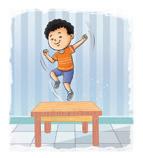
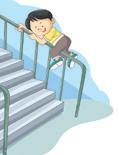
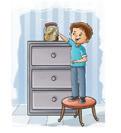

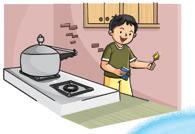
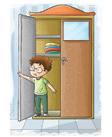
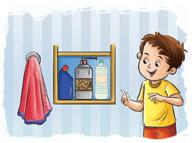
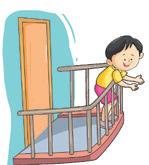



LO: Children will identify and name the animals emphasising their first letters.
Resources: Literacy Skillbook, page 75; a soft toy
1. Knowing the Animal Names: Say aloud names of a few animals, emphasising the first letter sound. For example: /k/ /k/ crocodile. Guide children to identify the beginning sound and the first letter of the animal. Try with different animal names.
2. Pass the Toy: Pass around a soft toy. Ask the child holding the toy to say aloud the name of a bird or an animal. Let other children guess the first letter of the animal names.
3. Animal Names: Guide children to open page 75 of the Skillbook. Guide them to identify the animals and name them. Help them identify the first letter of each animal and write it down.

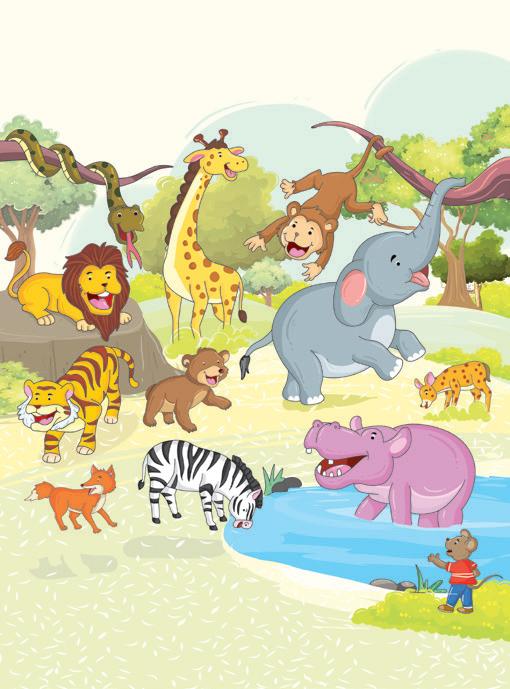

LO: Children will identify the concept of what comes before through real-life examples.
Resources: Some common classroom objects like: chalk, duster, pencils, crayons, etc.

1. Real Life Connections: Say: Let us think about what we do every day. What do we do before eating?
Prompt with real examples:
• We set the table.
• We wash our hands.
• We take some food on our plate.
Ask: What do you do before you come to school? Let children share their responses. Guide them to say: We eat breakfast. / We pack our school bags. / We wear our school uniform. Explain ‘before’ means what has already happened.
You can ask: What did we do before our numeracy class? Let children think and share their answers.
2. Object-Based Example: Use real classroom items placed in a row (e.g. chalk, crayon, pencil, duster etc.). Explain using an example: The chalk is placed before the crayon. Then, point to one object and ask: What is kept before this? Let children take turns identifying or picking the item kept before.
3. Identifying the Concept of What Comes Before: Call 3–4 children and ask them to stand in a line. Then, go to each child one by one and ask: Who is standing before you? Guide them to identify the concept of before and share their friend’s name. Ensure everyone gets a turn to take part in this activity.
LO: Children will recite the rhyme I’m a Little Teapot.
Resources: Rhymes and Stories, page 47
1. Warm-Up: Ask children to open page 47 of the Rhymes and Stories book. Show them the picture and ask: What do you see in this picture? Encourage each child to participate and give responses. Then say: This is a teapot. It is used for pouring tea in a cup.
2. Rhyme Time: Recite the poem I’m a Little Teapot with actions and expressions. Ask children to recite along. Repeat 3–4 times to help children learn the song.


Think of a fun line on a teapot and share it with the class the next day. For example: I am a little teapot, red and fun. Start the sentence using: I am a little teapot _________ and ________ (colour/shape/size/ emotions etc).
Domain
Circle Time
Topic of the Day
Keeping Our Environment Clean
General Awareness Safety at School
Book & Page
General Awareness, page 86
Foundational Literacy Join the Dots Literacy Skillbook, page 76
Foundational Numeracy What Comes Before Numeracy Skillbook, page 67
DIY Rhyme: I’m a Little Teapot Rhymes and Stories, page 47
LO: Children will listen to a story and discuss how we can keep our surroundings clean.
1. Story Time: Narrate the story Tara Goes to the Park with expressions and voice modulation. Discuss the story by asking questions like:
• Why do you think Tara was sad?
• What made the park look dirty?
• What did Tara and her friends do?
2. Real Life Connections: Say: Sometimes, we see garbage on the road or hear loud noise from cars. That is called pollution. It makes our Earth dirty and sad. But we can help! Share some examples like:
• We should throw wrappers in the bin.
• We should not waste water.
• We should use a cloth bag instead of a plastic bag.
Tara Goes to the Park Tara went to play in her favourite park. But when she got there, oh no! There was garbage on the grass, plastic bags near the flowers, and bottles in the pond. The birds flew away and Tara felt sad. She said, ‘The park looks so dirty!’ Tara called her friends. Together, they picked up the garbage with gloves, put it in the bin, and watered the plants. The park looked happy again!
Ask children to share what they would like to follow to keep the Earth clean.
Pro Tip
You can also discuss with children how they can keep their classrooms clean and tidy.

LO: Children will identify safety measures to follow at school.
Resources: General Awareness, page 86

1. Warm-Up Discussion: Say: School is a fun place to learn and play. But we must follow some rules to keep everyone safe. Ask simple questions:
• What do we do when we walk in the classroom?
• Do we push or pull our friends?
• What should we do if we get hurt? (Tell your teacher.)
Let children respond. Help them if they need. Recite the rhyme Safe in School with voice modulations and expressions.
2. Safety at School: Ask children to open page 86 of the General Awareness book. Guide them to look at the pictures and discuss them. For example, ask: Should we run on the stairs? Let children share their responses. Then say: We should not run on the stairs, or else we can fall down and hurt ourselves.
3. Safe or Unsafe: Call out different situations and ask children to show a thumbs up if it is safe and a thumbs down if it is unsafe. Give situations like: We should walk in a line. / We should jump on tables and chairs.







LO: Children will join the dots in alphabetical order to complete a picture. Resources: Literacy Skillbook, page 76; letter flashcards (from Skillbook)
Safety in School Walk, don’t run, Be kind, have fun! Use things with care, And always be fair!








1. Reciting A to Z: Recite A to Z in alphabetical order and let the children recite along. Repeat 3–4 times for reinforcement.
2. Arranging Letters: Pair up two children and give each pair the letter flashcards. If there is an odd number of children, make one group of three children. Ask them to arrange the letters in alphabetical order. Monitor and guide children as required.



3. Joining the Dots: Ask children to open page 76 of the Skillbook. Guide them to join the dots in an alphabetical order to complete the picture. At the end ask: What did we make? Let children observe and share their answers. Then, say: We made a dinosaur. Use crayons to colour the picture of the dinosaur on page 76 of the Literacy Skillbook.

LO: Children will identify the concept of before by observing different things and pictures.
Resources: Numeracy Skillbook, page 67; some common classroom objects (chalk, crayons or pencils)
1. Recap: Place three objects in a row, example: chalk, crayon and pencil. Explain that the chalk comes before the crayon / the crayon comes before the pencil. Repeat 3–4 times for reinforcement.
2. Identifying the Objects: Place any three objects in a row, example: a pencil box, a book and a water bottle. Call children one by one and ask them questions like: What comes before the book? / What comes before the water bottle? Guide children to identify and state the correct object. Ensure everyone gets a turn and change the objects each time you call a new child.
3. What Comes Before: Ask children to open page 67 of the Skillbook. Help them identify the concept of before from the picture. Then, guide them to circle the things that come before the ones shown.













LO: Children will recite the poem I’m a Little Teapot and share a fun line on a teapot.
Resources: Rhymes and Stories, page 47
1. Rhyme Time: Recite the rhyme I’m a Little Teapot with actions and expressions. Repeat 3–4 times. Guide children to do the following actions after they recite the rhyme:
• Pretend to hold the handle of a teapot.
• Pretend to pour some tea in the cup.
• Now, drink some tea from the cup.
2. Teapot Story: Say: Did you all think of a line about the teapot? Call children one by one and ask them to say two words to describe the teapot. Guide them to say: I am a Little Teapot _____ and _______. Cheer for each child and ensure everyone gets a turn.



Domain
Circle Time
General Awareness
Topic of the Day
Colour Mixing Fun
Safety at Road
Foundational Literacy Write the Missing Letter
Foundational Numeracy Do and Learn
DIY A Memory Game
Book & Page
General Awareness, page 87
Literacy Skillbook, page 77
Numeracy Skillbook, page 68
LO: Children will develop their cognitive skills by exploring how new colours are made by mixing primary colours.
Resources: A drawing sheet (1 per child); red, blue and yellow paint; earbuds or paintbrush; red, blue and yellow objects
1. Primary Colours: Show the red, blue and yellow objects and say: These are special colours—red, blue, and yellow. We call them primary colours. We can use them to make new colours! Show each colour one by one. Ask children to say the colour name aloud.
2. Colour Mixing: Provide the materials to the children (or they can work in pairs). Demonstrate first and then guide them to mix:
• Red + Yellow = Orange
• Blue + Yellow = Green
• Red + Blue = Purple
Let them use a brush or earbuds to mix small amounts of each pair of colours and paint a circle or shape with the new colour.
3. Wrap-Up Discussion: Ask: What colour did you get when you mixed red and yellow? Was it fun to make a new colour? Say: We used red, blue, and yellow to make beautiful new colours! You are colour scientists!

LO: Children will learn ways to stay safe on or near roads.
Resources: General Awareness, page 87
1. Warm-Up: Say: Today, we will talk about how to be safe when we are near or on the roads! Ask questions to spark thinking:
• What do we see on the road? (cars, buses, bikes, people)
• Do we run or play on the road? (No!)
• Do we cross alone? (No, we hold an adult’s hand)
2. Safety on Road: Ask children to open pages 87 of the General Awareness book. Guide them to look at the pictures and discuss them one by one. For example: Point to the first picture and read aloud the sentence given below. Ask: Should we run after pets on the street? Listen to all responses and say: We should not run after pets. They can get scared and jump on us. Repeat for other pictures.
3. Safe or Unsafe: Give some situations to children. Guide them to show a thumbs up if it is safe and a cross with both hands if it is unsafe. Give them situations like:
• We should run after pets on the street.
• We should not play near parked cars.
• We should not wear a helmet while riding a bicycle.








• We should take our hands out of a moving car. 87





LO: Children will identify and write the missing letters in the alphabetical order. Resources: Literacy Skillbook, page 77


1. Guess the Missing Letters: Write some letters on the board in a sequence, with some letters missing in between. For example: A, __, C, ___, ____ F. Guide children to find the missing letters. Guide them by asking questions like: What comes after A? / What comes before F? Repeat with other sequences, using lowercase letters too.

2. Write the Missing Letters: Ask children to open page 77 of the Skillbook. Guide them to read the letters and fill in the blanks with missing letters. Complete only the capital letter section in class.

Refer to page 77 of the Skillbook. Then, solve the small letter section by filling in the blanks.

LO: Children will learn what number comes before a given number.
Resources: Numeracy Skillbook, page 68
1. Number Train: Write numbers from 1 to 10 on the board and recite it once along with children. Say: Today we will identify which number comes before a given number. Circle a number on the number train, say 3 and ask: Which number comes before 3? Let children observe and share their responses. Then, point and show that 2 comes before 3. Repeat with other numbers.
2. What Comes Before: Call children one by one and give them a number, say 5. Guide them to identify the number that comes before. Ensure everyone gets a turn, give each child a different number.
3. Do and Learn: Ask children to open page 68 of Skillbook. Guide them to identify and write the numbers that come just before the given numbers.






LO: Children will play a fun game of observing things and identifying the changed order.
Resources: 5–6 familiar objects (e.g., book, spoon, crayon, toy car, cup, pencil)
1. Show and Observe: Place the objects in a row on the table. Name and point to each item to the children: Here is the book, next to it is the cup, then the crayon… Ask them to look carefully and remember where each item is.
2. Changed Order: Ask children to close their eyes. Quietly switch the position of two objects (e.g., swap the spoon and toy car). Say: Open your eyes! Look closely… What has changed? Let them guess what objects moved or changed places. Praise all efforts.
Domain
Circle Time
General Awareness
Topic of the Day
Before and After Story
Enacting Safety Rules
Book & Page
General Awareness, pages 84–87
Foundational Literacy Aa to Zz Literacy Workbook, page 47
Foundational Numeracy What Comes Before Numeracy Workbook, page 43
DIY My Crumpled Tortoise
Art and Craft, page 27
LO: Children will listen to a story and talk about what happened before and after the story.
1. Story Time: Narrate the story The Picnic Day with expressions and voice modulation. Repeat 3–4 times to help children remember story sequence.
2. Discussion Time: Discuss the story by asking questions to children. Ask questions related to before and after from the story:
• What did Mahek do before playing with her sister?
• What did Mahek do after playing?
• What did Mahek do after eating the sandwiches?
Help children remember the story sequence and answer the questions.
A Picnic Day Mahek went to a garden for a picnic with her family. First, she went and looked at all the beautiful trees and flowers in the garden. Then, she played with her sister. After that she felt hungry and ate some sandwiches. Finally, Makek went boating with her family in the nearby lake.
You can ask children to share their daily routine using the words before and after.

LO: Children will act out safety rules to follow at home, in school and on the road.
Resources: General Awareness, pages 84–87; chair; toy; pretend kitchen item; tape
1. Warm-Up Discussion: Say: We go to many places—like home, school, and outside. We must follow safety rules in all these places. Ask:

• What do we do before crossing the road?
• Do we play with sharp things at home?
• What should we do if there is water on the floor in school?
Let children share ideas. Support their answers with correct examples.
2. Pretend Play: Create simple pretend areas in the class for:
• Home (chair, toy, pretend kitchen item)
• School (desk, bag, crayons)
• Road (masking tape for road line, small stop/go signs)
Assign small groups and guide them through short role-play scenes:
Home Safety
• Not touching sharp objects in the kitchen.
• Not touching plug points.
• Not playing near a gas stove.
School Safety
• Walking in a line.
• Sharing things and not fighting.


• Asking a teacher before leaving the classroom.
Road Safety
• Holding hands while crossing the road.
• Walking and not running on roads.
• Wearing a helmet when riding a bicycle.
Use simple props and real classroom objects. You can ask children to enact other safety rules from pages 64–67 of the General Awareness book.



































LO: Children will write capital and small letters from Aa to Zz in the correct order.
Resources: Literacy Workbook, page 47
1. Recalling A to Z: Recall A to Z in a sequence by reciting the Letter Rhyme and ask children to sing along. Repeat 3–4 times.
2. Identifying Symbols Aa to Zz: Call children one by one and give them a letter. Ask them to write both capital and small letters on the board. Ensure everyone gets a turn with different letters.
3. Letters Aa to Zz: Ask children to open page 47 of the Workbook. Guide them to write letters Aa to Zz. Write letters on the board, in case children need help. Practise writing letters Aa to Zz in your notebooks.
LO: Children will identify what comes before a number or object. Resources: Numeracy Workbook, page 43







1. Looking at Objects: Keep 4–5 objects neatly in a row. For example: chalk – pencil – crayon – duster – book. Call children one by one and ask questions like: What comes before the duster? Let children observe and guide them to share their answers. Ensure everyone gets a turn.
2. Looking at Numbers: Write 1 to 10 on the board. Then call out a number (e.g. 6) and ask: What comes before 6? Let children share their answers and correct them, if required. Ensure everyone gets a turn.
3. What Comes Before: Ask children to open page 43 of the Workbook. Guide them to draw what comes before each object. Then, ask them to write the number that comes just before each given number.
LO: Children will decorate a tortoise by sticking origami paper on its shell. Resources: Art and Craft, page 27; origami papers (from Art and Craft book); glue
1. Warm-Up: Ask children to open page 27 of the Art and Craft book. Show them the picture and ask: What animal is this? Listen to all responses, and then say: This is a tortoise. Ask children to walk slowly on the spot like a tortoise.
2. My Crumpled Tortoise: Give the materials to children and ask them to open page 27 of Art and Craft book. First, ask them to crumple the origami paper and then, guide them to stick the crumpled paper on the shell of the tortoise.























Domain General Awareness
Learning Outcome Children will identify and share safety practices at home, in school and on the road.
Resources General Awareness, pages 84–87; a soft toy
Suggested Method Pass a soft toy around. Ask the child holding the soft toy to share about a safe habit that they should follow at home, in school and on the road. Provide them with situations and ask them to show a thumbs up if it's a good habit and a thumbs down if it's a bad habit. You can give situations like:
• We should play with sharp objects.
• We should not stand on tall stools.
• We should stand on swings
• Ask your teacher before you leave the classroom.
• Cross the road with an elder.
• Wear a helmet while riding a bicycle.
Clap for each child and give them a smiley. Ensure everyone gets a turn.
Support for Struggling Learners
Gather the learners together. Refer to pages 84–87 of the General Awareness book. Show the pictures one by one and help them identify the safety practices they should follow at home, at school and on the road.
Domain Foundational Literacy
Learning Outcome Children will identify the missing letters from a sequence of letters.
Resources Chalk
Suggested Method Call children one by one. Write a letter sequence on the board with a few letters missing in between. Clap for each child and give them a smiley. Ensure everyone gets a turn.
Support for Struggling Learners
Gather the learners together and recite the Letter Song (ABCD….) 3 to 4 times. Then write 4 letters with one or two letters missing in the sequence. For example A, ____, C, ___. Guide children to fill in the blanks with the missing letters. Guide them by asking questions like: What comes after A?
Domain Foundational Numeracy
Learning Outcome Children will identify the concept of what comes before
Resources Chalk
Suggested Method Call children one by one. Write a number on the board and ask: What comes before this number? Let children share their answers. Guide and correct them, if required. Clap for each child and give them a smiley. Ensure everyone gets a turn.
Support for Struggling Learners
Gather the learners together. Place 3 objects neatly in a row. Then, explain the concept of before using the objects. For example, say: There is a book before the pencil. Then write numbers from 1 to 10 in a row and explain what comes before a given number.





























Circle Time
General Awareness
Pick Up Race
Experiencing Water
Foundational Literacy Missing Letters Literacy Workbook, page 48
Foundational Numeracy
The Concept of Between
DIY Rhyme: Incy Wincy Spider Rhymes and Stories, page 48
LO: Children will develop their gross motor and socio-emotional skills by playing a game in pairs.
Resources: Classroom objects (crayons, toys, etc.); two baskets
1. Setting the Context: Say: Let’s play a fun game with our friends! You will work in pairs and see how many items you can pick up from the table! Scatter objects safely on a table in one corner of the classroom. Place two collection trays or baskets on the other side.
2. Pick Up Race: Divide children into pairs. Each pair will take a turn. When you say Ready, Go!, both children will race to pick up as many objects as they can and place them in their team’s basket. After 30 seconds or when you say Stop!, everyone counts how many objects they have picked. Say: Let’s see which pair picked up more! Great job working together!

LO: Children will explore the properties of water through observation and sensory play.
Resources: Small tubs or bowls with clean water; cups; spoons; plastic bottles; funnels; ladles; sponges; waterproof mat or newspaper for the floor; towels for drying hands
1. Warm-Up: Say: Today, we are going to explore something we use every day — water!
Ask:
• Where do we see water? (Bath, rain, taps, bottles)
• What do we do with water? (Drink, wash, water plants)
Let them share their answers.

2. Sensory Exploration: Set up water tubs on a table or floor (cover the area with waterproof mats/newspapers). Say: Now, let’s touch and play with water safely. Children can:
• Pour water from cup to cup
• Use funnels and bottles
• Squeeze sponges
• Stir with spoons
Encourage them to describe how it feels: Is it cold? Is it wet? Does it splash?
3. Observation and Clean-up: Ask children questions based on the activity:
• Is the water cold or hot?
• Can we hold water in our hands?
Let them help wipe hands and put materials away. Make it part of the learning.







LO: Children will identify and write missing letters in alphabetical order.
Resources: Literacy Workbook, page 48
Introduction
1. Identify the Correct Letter Sequence: Write an incorrect letter sequence on the board (e.g., A, G, C, B, F). Ask children to identify whether the sequence is correct or not. Ask them to spot which letter is out of order. Then, ask children to complete the sequence using the correct letters. Repeat with 4–5 varied examples.
Practice
2. Missing Letters: Ask children to open page 48 of the Workbook. Guide them to complete the train by filling in the missing letters.
LO: Children will recognise the concept of between through real-life examples. Resources: Common classroom objects—ball, pencils, bottles, books, chalk, etc.
Introduction










1. Discussion Time: Start by saying: Today we are going to learn a new word—between! ‘Between’ means something that is in the middle of two things. Use your hands to demonstrate: Look—this chalk is in between the two books! Ask: Who has ever sat between two friends? Give other examples like: Afternoon comes between morning and evening; we have our lunch between our breakfast and dinner, etc.
2. Demonstration Using Real Objects: Place a ball between two books. Say: The ball is between the books. Repeat with different objects (e.g. a pencil between two erasers). Call children one by one and allow them to take turns arranging items and saying what’s “between.”
3. Applying the Concept of Between: Ask three children to stand in a row. Then ask: Who is standing in between? Guide children to share the name of the child. Repeat with other children.
Look at different objects kept at home. Identify which ones are placed in between other items.
LO: Children will recite the rhyme Incy Wincy Spider with voice modulation and expression. Resources: Rhymes and Stories, page 48
1. Picture Talk: Ask children to open page 48 of the Rhymes and Stories book. Ask: What do you think is happening in the picture? What insect do you see? Let children share their responses. Then say: We see a spider being washed away by the water.
2. Rhyme Time: Recite the rhyme Incy Wincy Spider with voice modulation and expressions and ask children to follow and sing along. Repeat 3–4 times to help children remember the rhyme.
Ask children to name other insects they’ve seen at home or outdoors.

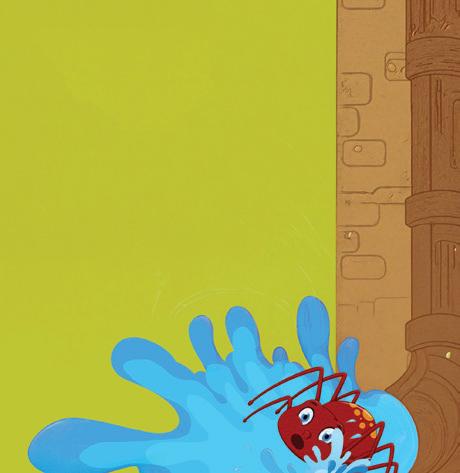

Circle Time Pass the Pattern
General Awareness Uses of Water
General Awareness, page 89
Foundational Literacy Beginning Sounds Literacy Workbook, page 49
Foundational Numeracy What Comes in Between Numeracy Skillbook, page 69
DIY Rhyme: Incy Wincy Spider
Rhymes and Stories, page 48
LO: Children will make simple patterns using colours or classroom objects.
Resources: Common classroom items (crayons, pencils, chalk, erasers, etc.)
1. Warm-Up: Say: Today, we are going to play a fun game called ‘Pass the Pattern’. We will make a pattern and pass it around! Give an example: pencil, eraser, pencil, eraser—that’s a pattern! Can you say it with me?
2. Model the Pattern: Create a simple AB pattern (e.g., a red crayon, a blue crayon). Show it to the children and say the pattern out loud: Red crayon, blue crayon, red crayon, blue crayon. Hand the first two items to the first child. Ask them to continue the pattern by choosing the next correct item and passing all to the next child. Repeat with a few children, and provide assistance as and when required. Continue the pattern around the circle. Once it returns to you, say: Wow! We kept the pattern going!
Try more complex patterns (e.g. AAB or ABB) if children are ready.

LO: Children will identify different uses of water and act them out.
Resources: General Awareness, page 89
1. Warm-Up: Say: Today we will talk about water. Then ask children to share ways they use water at home and at school. Listen to all responses.
2. Uses of Water: Ask children to open page 89 of the General Awareness book. Show pictures one by one and discuss how water is used. Then, ask them to tick the ways in which they use water.
3. Role Play: Give different pretend play situations to children and guide them to enact the same. For example: Let us pretend to drink water. / Let us pretend to take a bath. / Let us pretend to water plants. Ensure each child gets a chance to participate in the activity and assist those who need help.


















LO: Children will identify objects, their beginning sounds, and the first letter they start with.
Resources: Literacy Workbook, page 49; chalk
Introduction
1. Identify the First Letter: Call children one by one. Say aloud a word, emphasising the beginning sound, for example: /p/ /p/ pot. Guide children to guess the first letter and write it on the board. Ensure everyone gets a turn.
You can also show some common objects like a book, bag, chalk, pen, etc. and ask children to say the object’s name and its first letter.
2. Beginning Sounds: Ask children to open page 49 of the Workbook. Ask them to complete the first two rows of the page. Guide them to identify each picture, say its beginning sound, and write the first letter.
















Refer to page 49 of the Workbook, complete the last row by writing the first letter of each picture.


LO: Children will identify objects that are placed between two others.
Resources: Numeracy Skillbook, page 69; some common classroom objects (ball, book, chalk, pencils, etc.)
1. Recap: Place 3 objects in a row, for example: a book, a ball, and a chalk. Point and show children that the ball comes in between the book and the chalk. Repeat 3–4 times for reinforcement.
2. Identify What Comes in Between: Call children one by one, place 3–4 objects in a row. Ask them to identify and say what comes in between. Ask: What comes in between _____ and ______? Ensure everyone gets a chance and give different objects to each child.
3. What Comes Between: Ask children to open page 69 of the Skillbook. Help them identify what comes in between in each picture. Then, guide them to circle the object that is in between the given pair.














LO: Children will recite the rhyme Incy Wincy Spider and create a spider and water splash.
Resources: Rhymes and Stories, page 48; a drawing sheet (1 per child); round cut out (1 per child); 8 strips of paper (per child); black crayon; blue paint; glue
1. Rhyme Time: Recite the rhyme Incy Wincy Spider with actions and expression and ask children to follow and sing along. Repeat 3–4 times to help children remember the rhyme.
2. Making a Spider and Water Splash: Give the materials to children. First, ask them to colour the circle and strips with black crayon. Then guide them to paste the circle with four strips on each side to make spider legs. Ask them to dip their hands in blue paint and make a handprint on one side of the drawing sheet to make a water splash. Ensure children wash their hands after the activity.









Circle Time Hit the Target
General Awareness Water for Plants and Animals
General Awareness, page 90
Foundational Literacy Beginning Sounds Literacy Workbook, page 50
Foundational Numeracy Do and Learn
DIY Winter Tree
Numeracy Skillbook, page 70
Art and Craft, page 28
LO: Children will improve hand-eye coordination by hitting targets with a ball.
Resources: Soft ball; coloured tape or chalk
1. Set the Challenge: Make a circle on the floor using chalk or coloured tape. Say: We are going to play a game called ‘Hit the Spot’! See that circle? Let’s try to hit it with the ball! Point to the first spot and demonstrate gently throwing or rolling the ball to hit it.
2. Hitting the Spot: Call children one by one or in small groups. Let each child try to hit the spot by throwing or rolling the ball. Use encouraging words: Great try! Let’s aim again! Ensure each child gets a chance to participate in the activity.
You can change the spot’s position (closer or further) to keep it interesting.

LO: Children will understand the importance of water and why plants and animals need water.
Resources: General Awareness, page 90
1. Warm-Up: Say: We need water for so many things. Do you think plants and animals need water? Listen to all responses. Then explain that plants and animals also need water for drinking and cleaning themselves. Say: Some animals, like fish, dolphins, whales, live in water.

2. Water for Animals and Plants: Ask children to open page 90 of the General Awareness book. Show them the pictures and discuss each of them. Example: A fish lives in water. / The puppy is drinking water. Then ask children to look at the picture below, say: The boy is watering the plant. Ask them to trace the dots to complete the watering can and colour it.










LO: Children will identify pictures, their beginning sounds, and the first letter they start with.
Resources: Literacy Workbook, page 50; common objects (pencil, pen, book, crayon, ball, etc.)
1. Beginning Sound and First Letter: Place the objects neatly on a table. Call children one by one and ask questions like: Can you find the object that starts with /k/ sound? Let children identify the object and guide them to write the first letter on the board. Ensure everyone gets a turn.
2. Beginning Sounds: Ask children to open page 50 of the Workbook. Guide them to identify each picture, say its beginning sound, and write the first letter. Ask them to only solve the first two rows.
















Refer to page 50 of the Workbook. Solve the last row by writing the first letter.
LO: Children will identify what number comes in between
Resources: Numeracy Skillbook, page 70
Introduction
1. What Comes in Between: Write numbers from 1 to 10 on the board. Ask, for example: What number comes in between 1 and 3? Let children observe and try to identify the number. Then, circle 2 and say: 2 comes in between 1 and 3. Try with different numbers.
2. Identifying Numbers in Between: Call children one by one. Ask them to refer to the number sequence and identify the number that comes in between. For example, ask: Can you say what comes in between 6 and 8? Let children point and say aloud the number. Ensure everyone gets a turn.
3. Do and Learn: Ask children to open page 70 of Skillbook. Guide children to identify and write the number that comes between each pair.






LO: Children will create a winter tree by painting with cotton balls.
Resources: Art and Craft, page 28; cotton ball (1 per child); white paint
1. Talking about Winter: Begin by asking: How do you feel in winter? Listen to all responses and say: We feel cold and dry in winter. Then explain that in winters the trees dry up and in very cold places they get covered in snow. Say: Today we will make a snow-covered tree.
2. Winter Tree: Ask children to open page 28 of the Art and Craft book. Demonstrate how to dip the cotton in white paint and press gently to make snowy leaves on the winter tree.





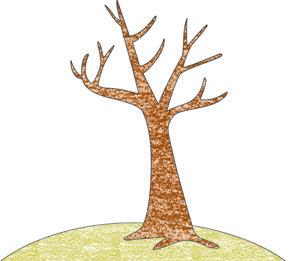

Circle Time
Beginning Sound Chain
General Awareness Water for Animals and Birds
General Awareness, pages 90–91
Foundational Literacy Before and After Letters Literacy Workbook, page 51
Foundational Numeracy What Comes Between Numeracy Workbook, page 44
DIY Spring Tree
Art and Craft, page 29
LO: Children will identify and recall words that begin with a given sound.
1. Warm-Up: Say: We are going to play a sound chain! We will say words that start with the same sound. Let us start with the sound /a/.
2. Start the Chain: Say: I will begin! /a/ /a/ apple. Point to a child: Your turn – can you think of a word that starts with /a/? Children continue naming words with the /a/ sound (e.g. ant, axe, alligator, etc.) If they get stuck, support with prompts: What about something we eat? Or an animal?
3. Change the Sound: After a few children have shared, say: Now listen—change to /d/ /d/! Children switch to the new sound and say: /d/ /d/… Continue the word chain with /d/ sound words (e.g., dog, drum, door, duck). Ensure each child participates in the activity.

LO: Children will understand the importance of water and discuss why plants, animals, and birds need water.
Resources: General Awareness, pages 90–91; crayons
1. Recap: Ask children to share why animals and plants need water. Listen to all responses. Refer to page 90 of the General Awareness book and discuss the picture. Ask questions like: What is the puppy doing? / What is the elephant doing? / What is the boy doing?
2. Birds Need Water: Ask: Do you think birds need water? Let children share their responses. Then say: Birds also need water for drinking and cleaning themselves. Some birds, like ducks and swans, swim in water.



3. Water for Birds: Ask children to open page 91 of the General Awareness book. Ask: What are the birds doing? Let children share their responses and say: The birds are drinking water. Guide them to trace the lines to complete the birds and then colour them.












LO: Children will identify the sequence of letters and write the letters that come before or after a given letter.
Resources: Literacy Workbook, page 51; letter flashcards (from Skillbook)
1. Warm-Up: Begin with singing the ABC song slowly and clearly. Encourage children to sing along with you and say each letter aloud. Emphasise certain letter groups like A–B–C or M–O so they hear the order.
2. Stand Up Letter Line: Say: Now we are going to become the alphabet! Ask 5–6 children at a time to come up and pretend to be letters. Assign each child a letter flashcard. (Example: You are A, you are B, you are C…). Ask them to stand in a line in the same order. Point to one child and ask:
• Which letter is standing before you?
• Which letter is standing after you?
Repeat with different children, mixing letters each time. If children forget their letters, remind them and say it together as a group.
3. Before and After Letters: Ask children to open page 51 of the Workbook. Ask them to look at the letters and write the letters that come before and after. Guide them by asking questions like: What comes before D? / What comes after M? Ask children to solve only the first two rows for before and after letters (pink and blue coloured rows).





Refer to page 51 of the Workbook. Solve the last row (green colour) for before and after letters by filling in the letters.


LO: Children will identify which objects and numbers come between others.
Resources: Numeracy Workbook, page 44; classroom objects (crayon, book, pencil, chalk, pen, duster, etc.)
1. Looking at the Objects: Keep 4–5 objects neatly in a row. For example: chalk – pencil – crayon – duster – book. Call children one by one and ask questions like: What object comes between the pencil and the duster? Let children observe and guide them to share their answers. Ensure everyone gets a turn.
2. Looking at the Numbers: Write numbers from 1 to 10 on the board. Then call out and number (e.g., 6) and ask: What comes before 6? Let children share their answers and correct them, if required. Repeat the activity with a few numbers and ensure everyone gets a turn.
3. What Comes Between: Ask children to open page 44 of the Workbook. Guide them to look at the pictures and draw things that come between the two things shown. Then, ask them to write the numbers that come between the two given numbers.
LO: Children will create a spring tree by painting with cotton balls.
Resources: Art and Craft, page 29; cotton balls; pink paint
1. Warm Up: Say: Spring comes after winter. The trees are filled with colourful flowers during the spring season.
2. Spring Tree: Ask children to open page 29 of the Art and Craft book. Demonstrate how to dip cotton in pink paint and press to make leaves on the spring tree.





























Domain General Awareness
Learning Outcome Children will identify how we use water and ways to save it.
Resources General Awareness, page 89; a soft toy; a bottle filled with water.
Suggested Method Begin by saying: Water is very important for us We need to save water and not waste it
Call children one by one and ask them the following:
• Can you mention some ways in which we use water?
• Can you share some ways in which we can save water? (Encourage them to enact and show if possible)
Clap for each child and give them a smiley. Ensure everyone gets a turn.
Support for Struggling Learners
Gather the learners together. Show a bottle of water and ask: Why do we need water?
Let children share their answers. Encourage responses like drinking, bathing, washing and cleaning. Then, refer to page 89 of the General Awareness book and discuss uses of water with the help of pictures.
Domain Foundational Literacy
Learning Outcome Children will identify the beginning sounds and first letter of a few objects.
Resources Chalk; some classroom objects like (bag, chalk, ball, pen, book, etc.)
Suggested Method Call children one by one. Say aloud name of an object emphasising on beginning sound, for example: /b/ /b/ bag. Guide children to identify the first letter and write the symbol on the board. Clap for each child and give them a smiley. Ensure everyone gets a turn.
Support for Struggling Learners
Domain
Keep some common objects like ball, toy, cap, pen, book, etc. Gather the children in a circle. Show them objects one by one and say aloud the name of the object emphasizing on the beginning sound, for example /b/ /b/ bag. Then, guide children to guess the first letter of the object. For example, ask: Which letter makes /b/ sound? Repeat with other objects.
Foundational Numeracy
Learning Outcome Children will identify the objects and numbers that come in between.

Resources Chalk; some classroom objects
Suggested Method Call children one by one. Write two numbers on the board with one missing between them (e.g., 3, __, 5) and ask: What comes between these two numbers? Let children share their answers. Guide and correct them, if required. Clap for each child and give them a smiley. Ensure everyone gets a turn.
Support for Struggling Learners
Gather the learners together. Place 3 objects neatly in a row (book, chalk, ball). Then, explain the concept of between using the objects. For example, say: The chalk is in between the book and the ball). Then write numbers from 1 to 10 in a row and explain what number comes in between the two numbers.




































The early years shape a child’s cognitive, social, and emotional growth. The DAWN Curriculum, aligned with NEP 2020 and NCF-FS 2022, integrates the Panchakosha framework to nurture well-rounded development—physical, emotional, intellectual, social, and moral. This manual ensures progressive, engaging, and hands-on learning through a structured teaching model, and provides special days dedicated for reinforcement and enrichment activities.
Equipped with helpful alerts, pro-tips, and best practices, this manual makes teaching seamless, interactive, and impactful. With play-based activities and multisensory techniques, teachers can confidently create a stimulating, joyful, and inclusive classroom.
• 180-Day Teaching Plan: Well-paced progression with built-in revision days.
• 4+1 Teaching Model: Structured learning with a dedicated reinforcement day.
• Panchakosha Framework: A holistic approach to early childhood development.
• DIY & Hands-on Learning: STEM, Art & Craft, storytelling, and interactive activities.
• Dynamic Circle Time: Engaging discussions, mindfulness, and movement-based activities.
• Multisensory & Play-Based Approach: Enhancing retention through interactive learning.
• Error Alerts & Pro-Tips: Practical guidance for smooth and effective teaching.
Uolo partners with K-12 schools to provide technology-enabled learning programs. We believe that pedagogy and technology must come together to deliver scalable learning experiences that generate measurable outcomes. Uolo is trusted by over 15,000+ schools across India, Southeast Asia and the Middle East.
ISBN 978-81-985727-3-8

hello@uolo.com